3 Days in Athens
Athens is the capital of the majestic ancient civilization, the birthplace of philosophy and democracy, probably everyone plans to visit here at least once in their life. This giant metropolis is fraught with many interesting objects that are definitely worth a visit.
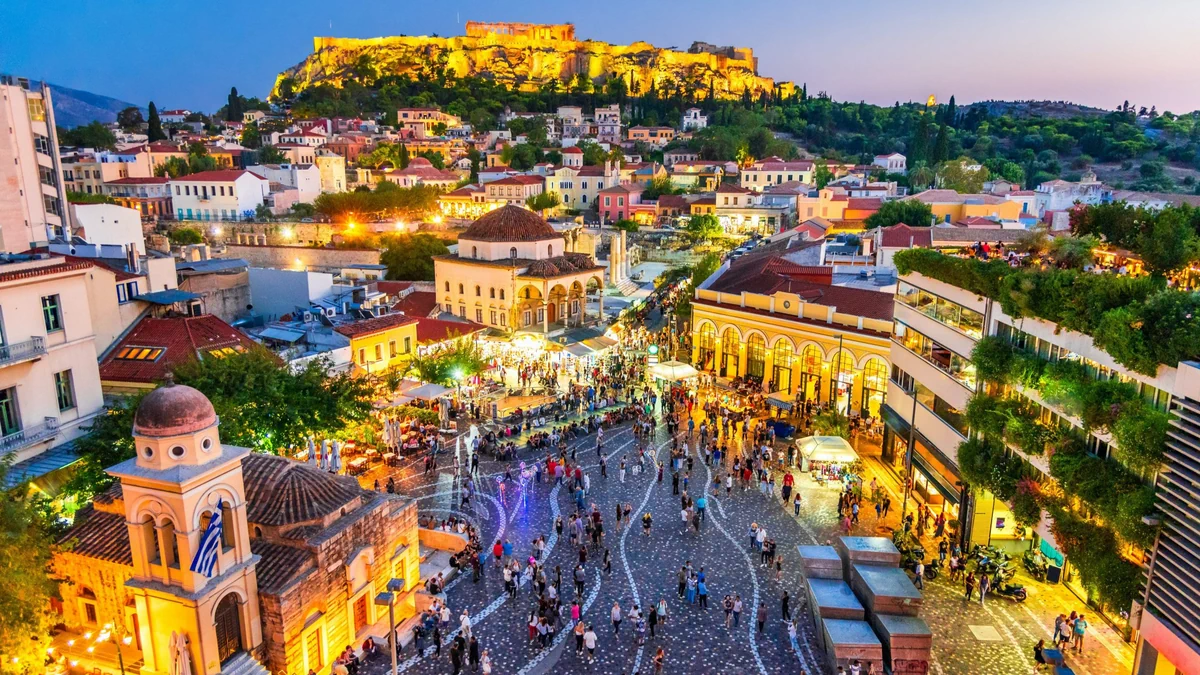 Often Athens is not the final destination or the only one for the guests of Hellas. Usually, having visited some other region of Greece, guests also visit the capital, or vice versa.
Often Athens is not the final destination or the only one for the guests of Hellas. Usually, having visited some other region of Greece, guests also visit the capital, or vice versa.
The city has good transport links and all types of public transport are available for every taste and budget.
Arriving at the airport of Athens, following the signs, after 3 minutes you will find yourself in the metro, go to the central square of Sindagma in just 30 minutes on the red line, the ticket price is 9 euros. Well, if you want to save a little, then on the street near the arrival terminal, there is a bus stop X95 which also goes to the central square and costs 5.5-6.5 (depending on where you buy the ticket), just ride it for about 50 minutes.
A very profitable option is to purchase a three-day tourist pass for all types of public transport, including a trip from and to the airport, the cost of such a ticket is 20 euros. After boarding the bus, the ticket must be brought to the scanner, from that moment it will begin to operate.
When you are planning a visit to Athens, it would be more logical to settle closer to the center in order to save time on the road and see as many sights as possible, of which there are an incredible number.
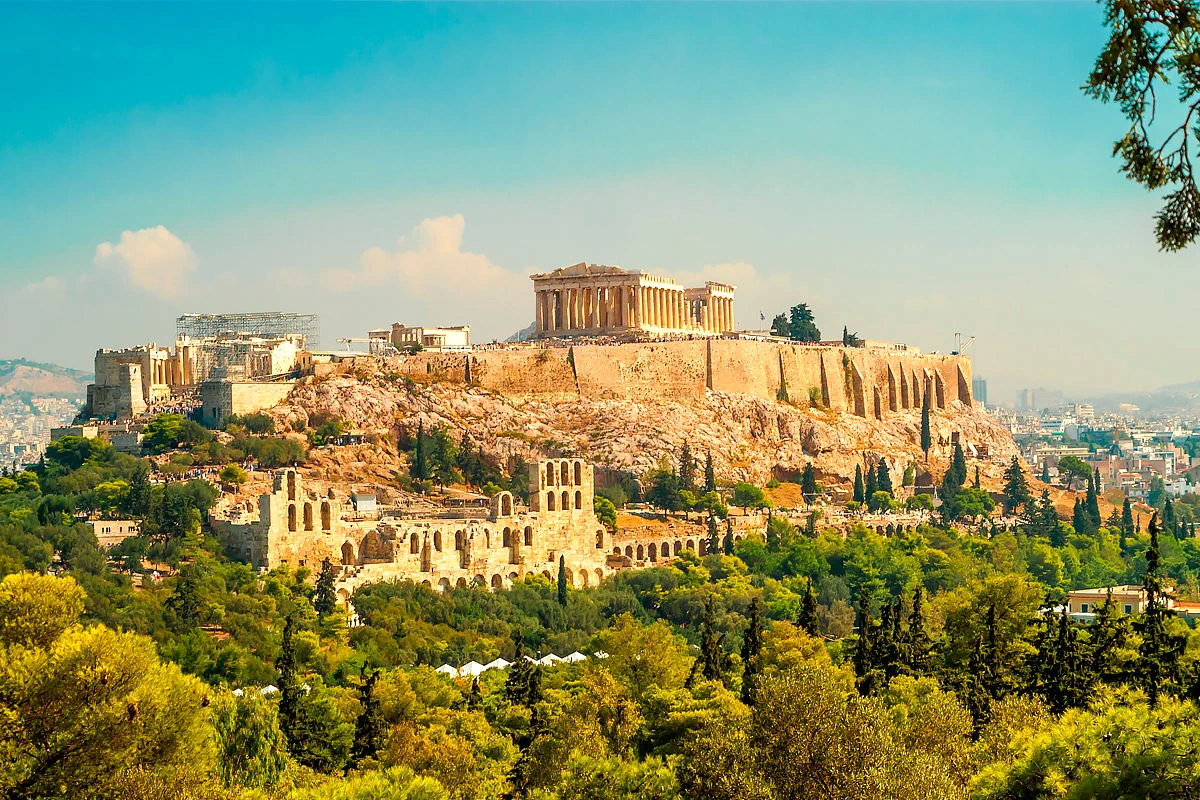 Monuments of the Acropolis, harmoniously combined with the surrounding nature, are unique masterpieces of ancient architecture.
Monuments of the Acropolis, harmoniously combined with the surrounding nature, are unique masterpieces of ancient architecture.
If you settled in the center, then we advise you to walk along the streets of Athens and enjoy the Hellenic flavor. Depending on the season, the opening hours of the facilities also change, keep in mind. For all municipal attractions and museums, information on opening hours and entrance fees can be found here: odysseus.culture.gr
On a rocky hill Acropolis, towering above the center of modern Athens, was the largest and most grandiose sanctuary of the ancient city, dedicated primarily to its patron goddess Athena.
The most important myths of ancient Athens, the main religious holidays, the oldest cults of the city and some of the most important events in its history are associated with this sanctuary.
Parthenon, standing majestically on the highest point of the Acropolis, this impressive temple was the most majestic in the ancient world. For a better view of the Parthenon from afar, head to Philopappos hill right in front of the Acropolis.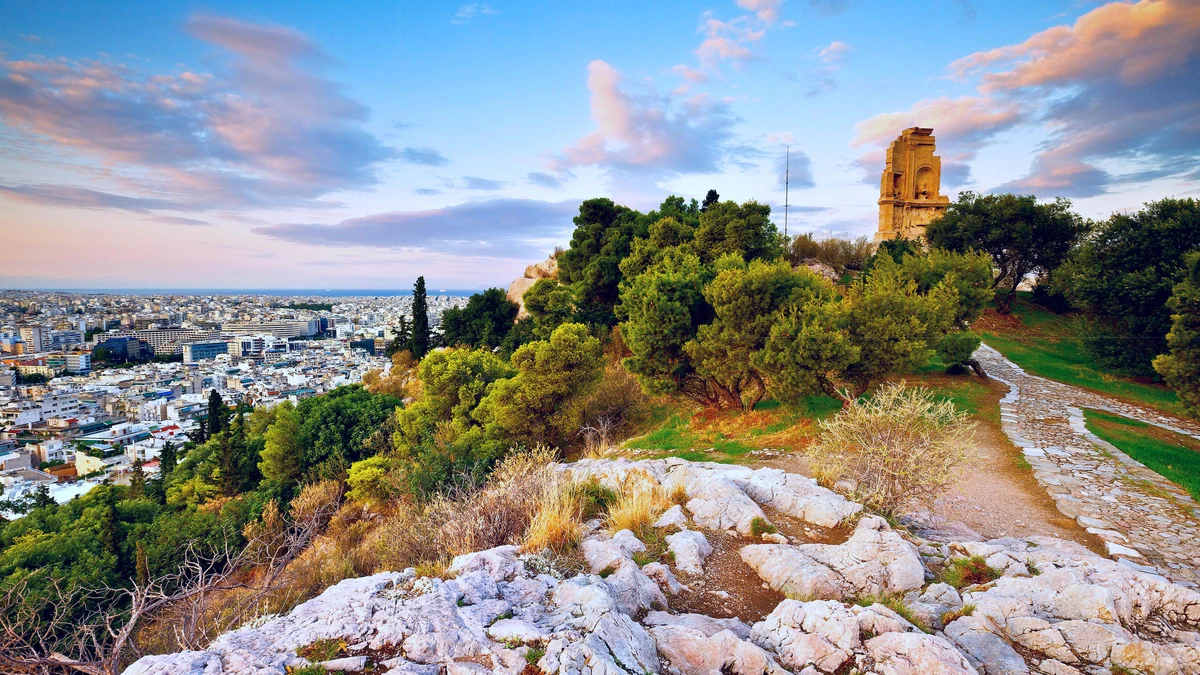 Wandering through the numerous archaeological finds of the Acropolis, you follow in the footsteps of Socrates, Pericles and Sophocles and discover the architecture of Western civilization. Since the Acropolis Parthenon was the center of attention, there are many sights around it which must be visited.
Wandering through the numerous archaeological finds of the Acropolis, you follow in the footsteps of Socrates, Pericles and Sophocles and discover the architecture of Western civilization. Since the Acropolis Parthenon was the center of attention, there are many sights around it which must be visited.
Before entering the territory of the Acropolis, you can go to amphitheater of Herod Atticus. This ancient theater is named after Herod Atticus of Marathon, who built it in memory of his wife Regilla in 161 AD, despite the date of construction, it is very well preserved.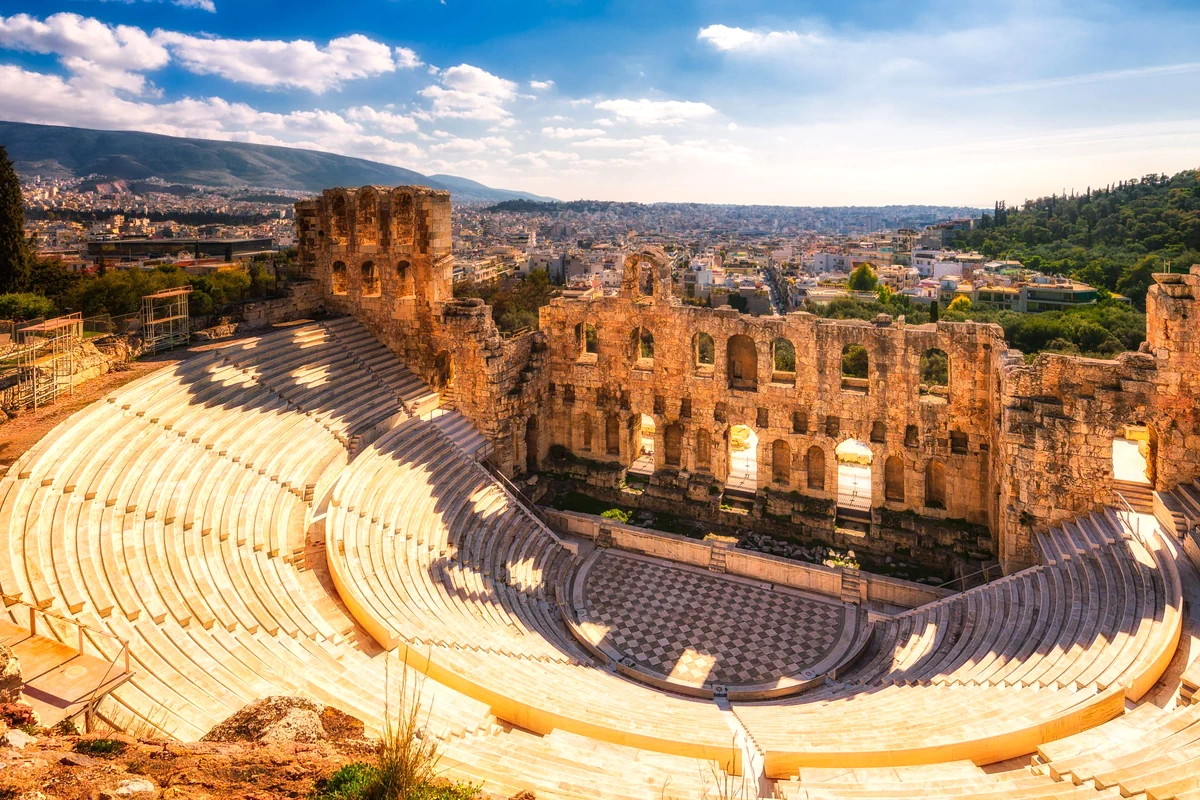 Beule Gate is located under the western side of the Propylaea, the magnificent entrance to the Acropolis. The gate with two side towers dates back to 280 BC. and were originally connected to the Propylaea by a wide marble staircase built during the reign of Emperor Septimius Sivir.
Beule Gate is located under the western side of the Propylaea, the magnificent entrance to the Acropolis. The gate with two side towers dates back to 280 BC. and were originally connected to the Propylaea by a wide marble staircase built during the reign of Emperor Septimius Sivir.
Temple of Athena Nike – the most elegant and well-preserved of all the buildings of the Acropolis, restored in the 19th and 20th centuries. Situated on a rocky cliff on the southern side of the Propylaea, this ancient sanctuary was dedicated to the victory-bringing goddess Athena (Nika). The temple was built between 432 and 421. BC, after the completion of the Parthenon and Propylaea.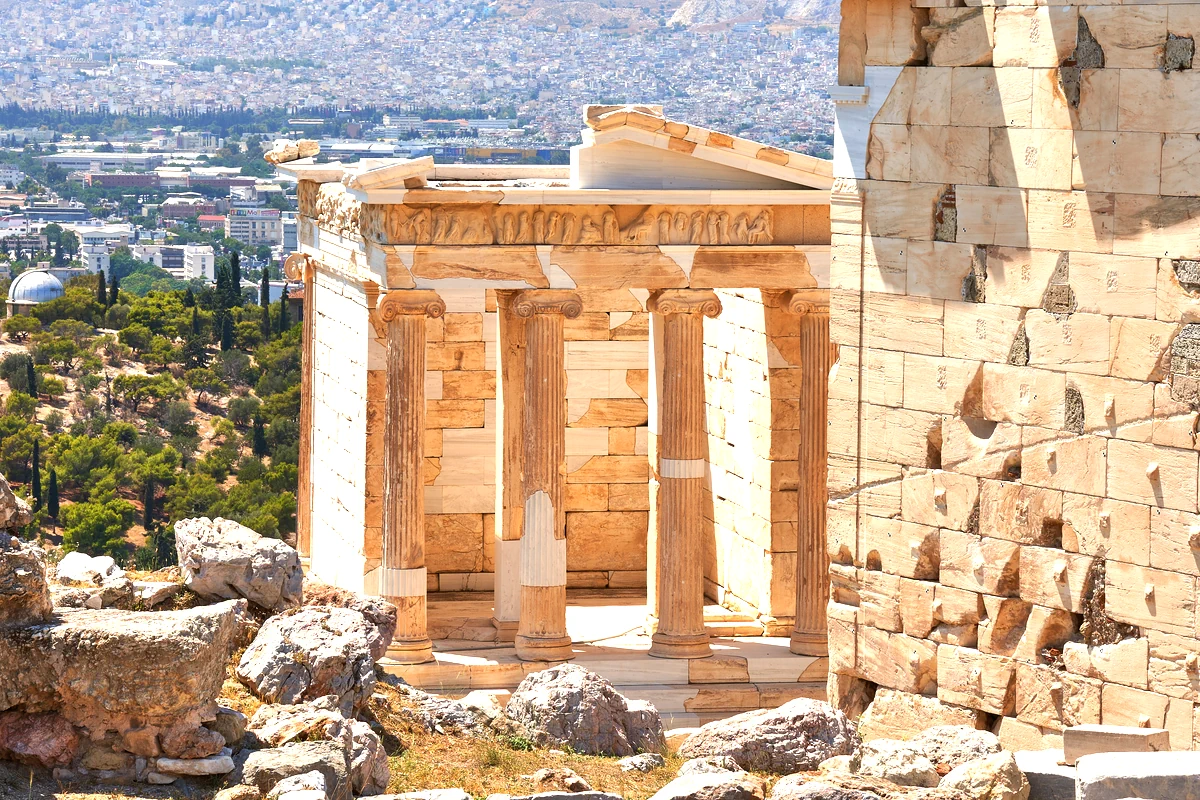 On the western side of the hill, tomb of king Erechtheion. One of the most famous features of the Erechtheion is the Veranda of the Caryatids – six marble columns in the form of figures of girls supporting the roof, fascinate with their appearance.
On the western side of the hill, tomb of king Erechtheion. One of the most famous features of the Erechtheion is the Veranda of the Caryatids – six marble columns in the form of figures of girls supporting the roof, fascinate with their appearance.
Pandroseion located between the Erechtheion and the Old Temple of Athena Polias. This small temple was named after Pandrosia, daughter of the first king of Athens. The temple contained the altar of Zeus Herkeyos (the patron saint of the hearth) and the sanctuary of Pandora. Scientists believe that the sacred snakes of the Acropolis were kept here.
Ancient Athenian Agora,located northwest of the Acropolis, in ancient times it was the administrative, philosophical, educational, social, cultural and especially economic center of the city.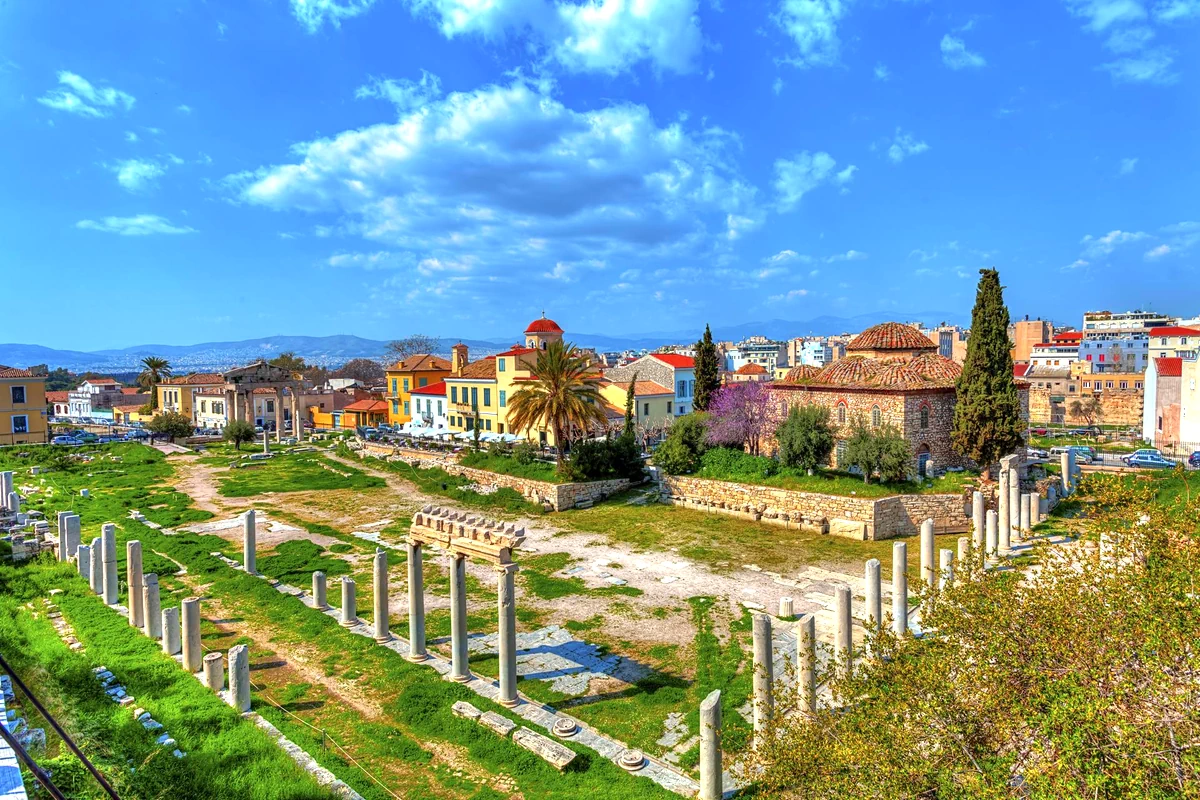 Roman Agora was the central market in ancient Athens during the Roman Empire. It was here that commercial transactions and meetings took place. The Roman market was created as an extension of the ancient market (Athensian Agora) to meet the needs of the daily life of the city. When the construction of the Roman market was completed, this street was decorated with a beautiful passage.
Roman Agora was the central market in ancient Athens during the Roman Empire. It was here that commercial transactions and meetings took place. The Roman market was created as an extension of the ancient market (Athensian Agora) to meet the needs of the daily life of the city. When the construction of the Roman market was completed, this street was decorated with a beautiful passage.
The Acropolis Museum is a must-visit cultural attraction in Athens. Beneath the hill of the Acropolis, about 300 meters from the archaeological site, this incomparable museum contains one of the most valuable collections of ancient Greek art in the entire world.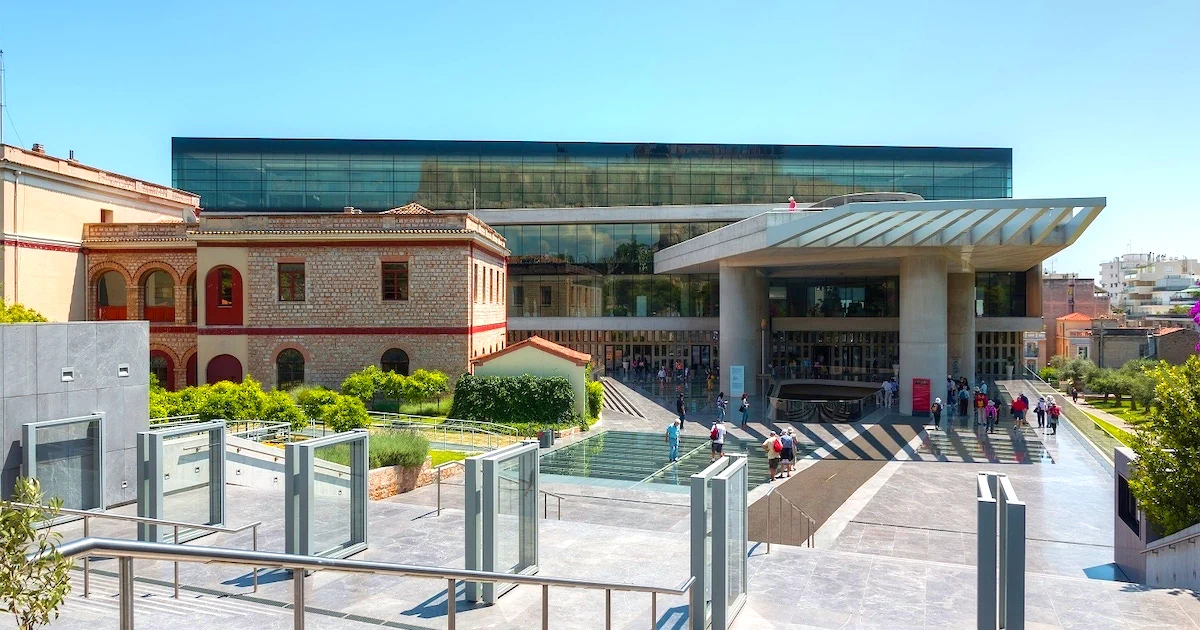 Theater of Dionysus fourth century BC – the oldest of the three architectural complexes built on the southern slopes of the Acropolis (Areopagite Street). The tragedies of Sophocles and Euripides were played here for the first time.
Theater of Dionysus fourth century BC – the oldest of the three architectural complexes built on the southern slopes of the Acropolis (Areopagite Street). The tragedies of Sophocles and Euripides were played here for the first time.
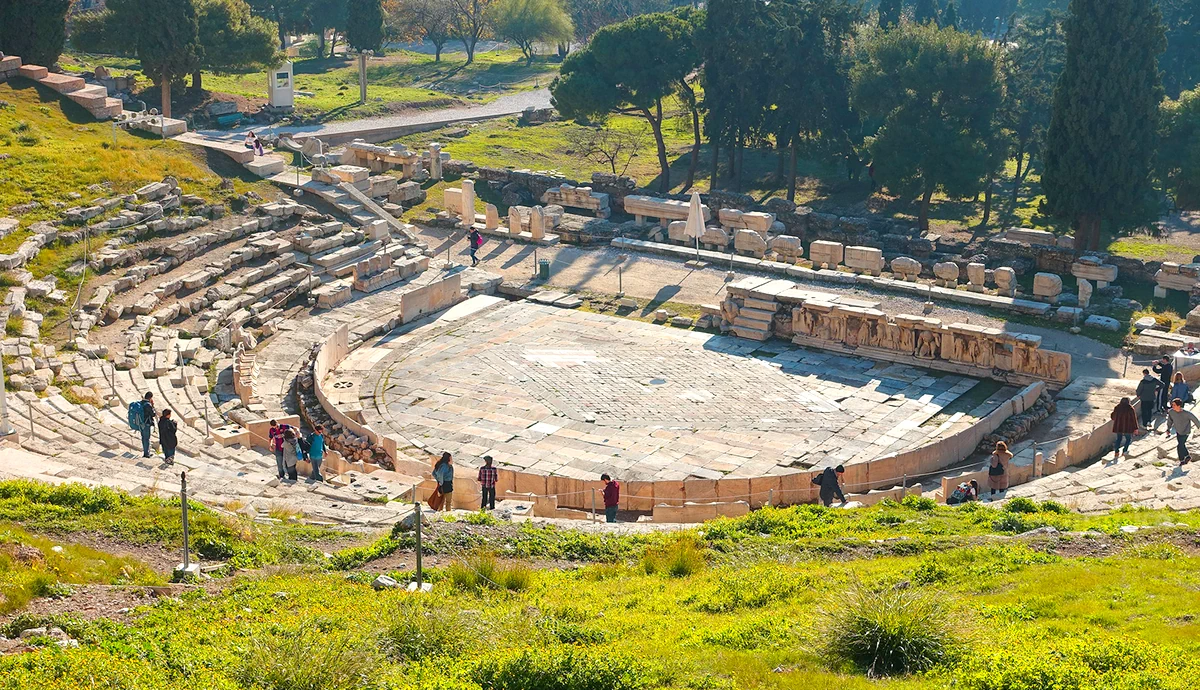 Hadrian’s Gate (or Hadrian’s Arch) – this is a monumental gate, reminiscent – according to some opinions – of a Roman triumphal arch. They blocked the ancient road from the center of Athens to the settlement complex on the eastern side of the city, which contained the Temple of Olympian Zeus.
Hadrian’s Gate (or Hadrian’s Arch) – this is a monumental gate, reminiscent – according to some opinions – of a Roman triumphal arch. They blocked the ancient road from the center of Athens to the settlement complex on the eastern side of the city, which contained the Temple of Olympian Zeus.
Temple of Zeus, one of the most important and most visited sanctuaries of ancient Athens, whose fate coincided with the political changes that took place in the city over the centuries. It is located southeast of the Acropolis.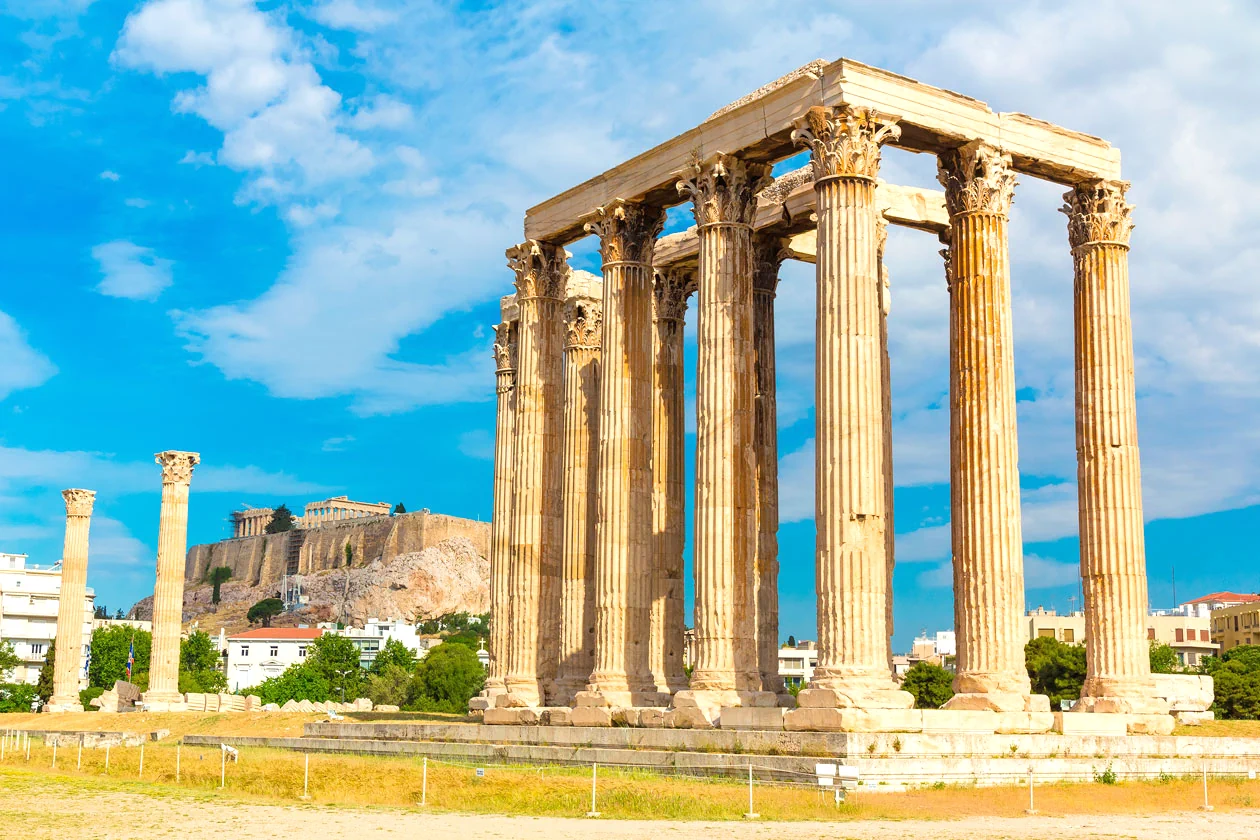 I can say with accuracy that after so many sights you are hungry and need a rest. Around the Acropolis Museum and near the Acropolis metro station, there are many local taverns and restaurants for every taste. It should be noted that the view of the acropolis is especially mesmerizing in the evening.
I can say with accuracy that after so many sights you are hungry and need a rest. Around the Acropolis Museum and near the Acropolis metro station, there are many local taverns and restaurants for every taste. It should be noted that the view of the acropolis is especially mesmerizing in the evening.
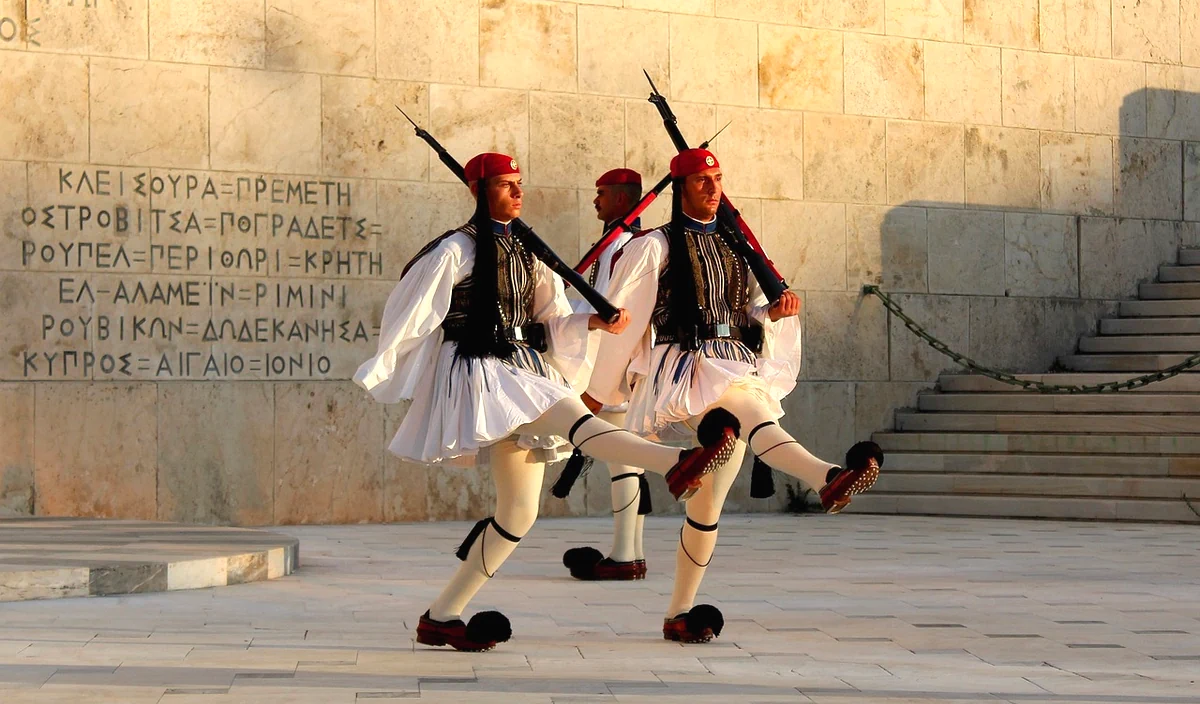 If you are in the capital on another day, then you can watch a miniature of this procession every hour.
If you are in the capital on another day, then you can watch a miniature of this procession every hour.
A band of Evzones (meaning “well-dressed”) was created by King Otto for the personal protection of the royal family. Their uniforms were based on the traditional costumes of the southern Greeks of the 19th century. The red fez symbolizes the bloodshed of 21 revolutions against the Turks, the black border is the tears of the Greeks during the Turkish occupation, and the 400 folds on the skirt are 400 years of slavery under the Turks.
In the first half of the day, it is worth taking a walk along the narrow shopping streets of the city, such as Ermou street, walking along it from the central square you will get to Monastiraki.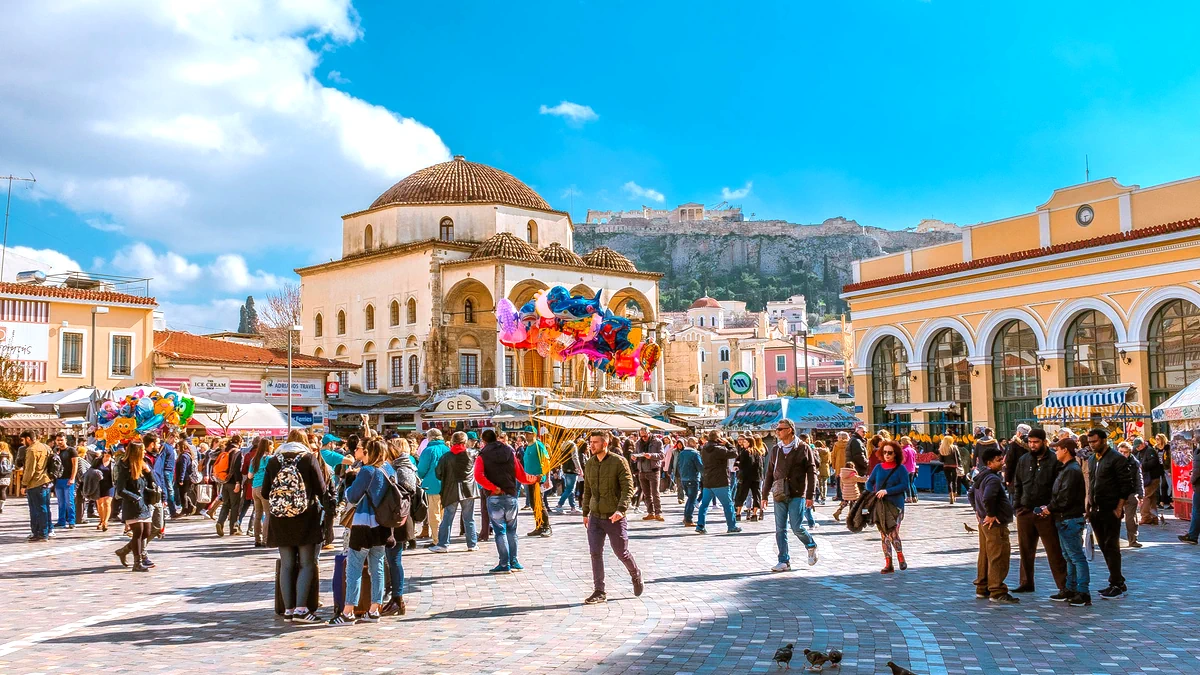 Monastiraki square is part of an old Catholic monastery. During the Frankish rule it was a private Monastery of Nicholas Bonefatsis. Located nearby Mosque of Tsistrakis, built by the Turkish governor Tsistarakis in 1759 from material obtained by destroying ancient buildings. For the marble plastering of the walls, the 17th column of the Temple of Olympian Zeus was blown up. The old Athenians believed that under every pillar of the temple lay a curse, which was confirmed by the outbreak of famine in the city.
Monastiraki square is part of an old Catholic monastery. During the Frankish rule it was a private Monastery of Nicholas Bonefatsis. Located nearby Mosque of Tsistrakis, built by the Turkish governor Tsistarakis in 1759 from material obtained by destroying ancient buildings. For the marble plastering of the walls, the 17th column of the Temple of Olympian Zeus was blown up. The old Athenians believed that under every pillar of the temple lay a curse, which was confirmed by the outbreak of famine in the city.
From the Monastiraki metro station you can get to any part of the city, if you have purchased a 3-day pass, take advantage of the moment and ride the tram around the city.
Near Monastiraki Square is located Abyssinia square where is located market (“Yusurum”), formerly known for its antique shops.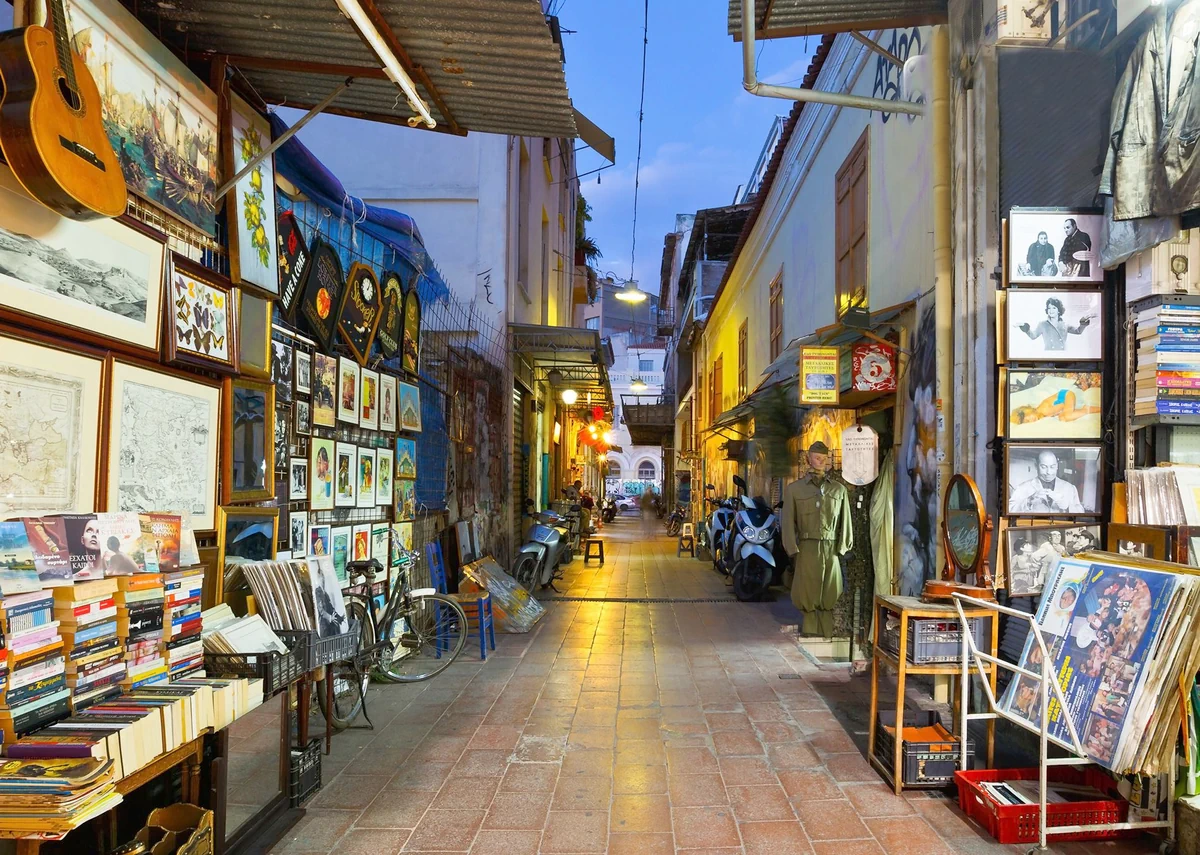 Today, there are still many antique dealers here. If you are a collector, this area is not to be missed. It is worth noting that this historical place is bordered by no less picturesque Plaka district.The best way to enjoy the color of these streets is to walk along them.
Today, there are still many antique dealers here. If you are a collector, this area is not to be missed. It is worth noting that this historical place is bordered by no less picturesque Plaka district.The best way to enjoy the color of these streets is to walk along them.
Buildings over 100 years old, painted in pastel colors, will take you centuries into the past. Is Plaka the oldest street in Europe? We are talking about Trypodon Street, which has retained the same name for almost twenty-five centuries.
Since Plaka is one of the oldest parts of Athens, this is where you will find many Byzantine and post-Byzantine churches. The most famous of them is Saint Nicholas Ragava and Savior Likodim. Built in the 11th century on Prytaneiu Street, in Anafiotika. In Byzantine times, the area around the church was the most aristocratic quarter of Athens. As for the name, the church was built by the grandson of the Byzantine emperor Michael Ragabas I on the site of a former Roman temple.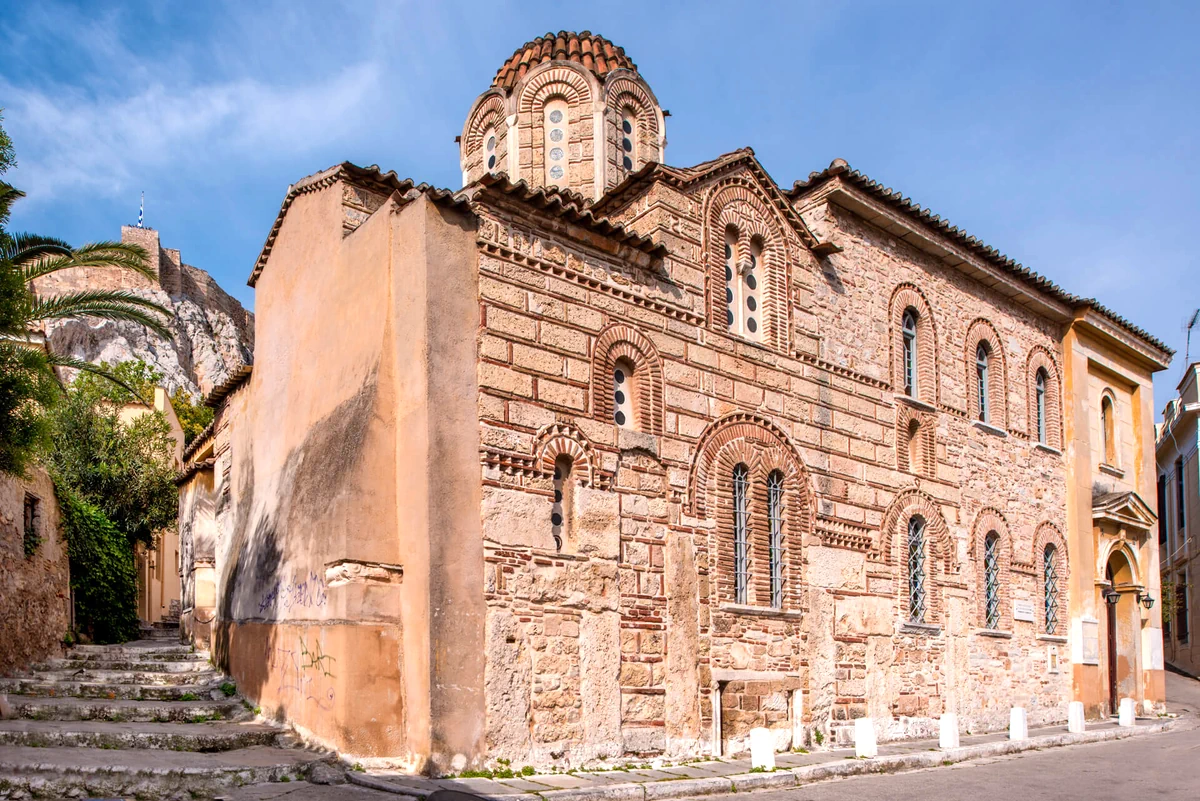 Another historic building worth spending time on is − Church of the Savior Lykodem, better known as the “Russian Church”. It was first built around 1031 AD and restored in the 19th century. Today it is the largest surviving medieval building in Athens. Located on Phillinon Street, opposite the National Garden.
Another historic building worth spending time on is − Church of the Savior Lykodem, better known as the “Russian Church”. It was first built around 1031 AD and restored in the 19th century. Today it is the largest surviving medieval building in Athens. Located on Phillinon Street, opposite the National Garden.
Walking through the historical places of the city you will find yourself in the national garden. You must have noticed it before. On hot summer days, the best time to visit it is lunch. When the sun heats up asphalt and marble outside, you can enjoy the coolness under the crowns of numerous trees. Together with the garden of the Zappeion Palace, it covers 284 acres full of greenery, rare species of plants, trees and birds.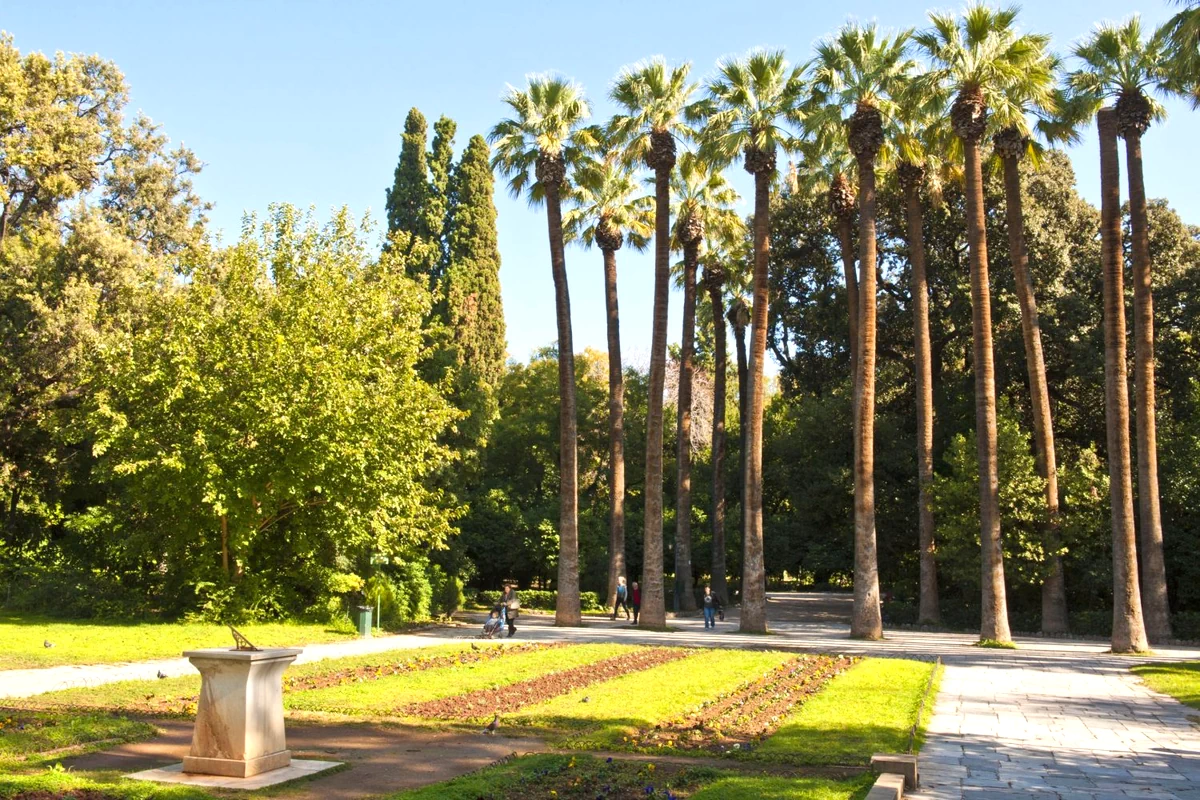 The garden can be accessed from seven entrances. From the main entrance on Amalias Avenue, from Vasilissis Sophia Avenue, from three entrances on Irodu Atticus Street and from two more in the Zappeion Park area.
The garden can be accessed from seven entrances. From the main entrance on Amalias Avenue, from Vasilissis Sophia Avenue, from three entrances on Irodu Atticus Street and from two more in the Zappeion Park area.
Before being renamed the National Garden in 1924, the garden was called the Royal Garden or Amalia Garden, to which it owes its rare existence. The interest of Queen Amalia, King Otto’s wife, in the garden was so great that it is said that she spent at least three hours a day tending it. She also planted the garden’s characteristic Washingtonia, about 25 m high, which can be seen when entering the garden from Royal Avenue Amalia.
An attraction that fascinates not only foreign visitors to the Garden, but also the Athenians themselves, is the famous sundial located at the main entrance. The shadow of the arrow, depending on the position of the sun, shows the relative time, and everyone goes on an adventure to guess the exact time without looking at the clock or mobile phone, thus mentally traveling for some time into the distant past.
One of the most beautiful neoclassical buildings in Athens, opposite the National Garden and the Greek Parliament building, houses one of the most impressive museums: Benaki Museum of Hellenic Culture, where you will find unique works from the beginning of Greek history to the creation of the modern Greek state.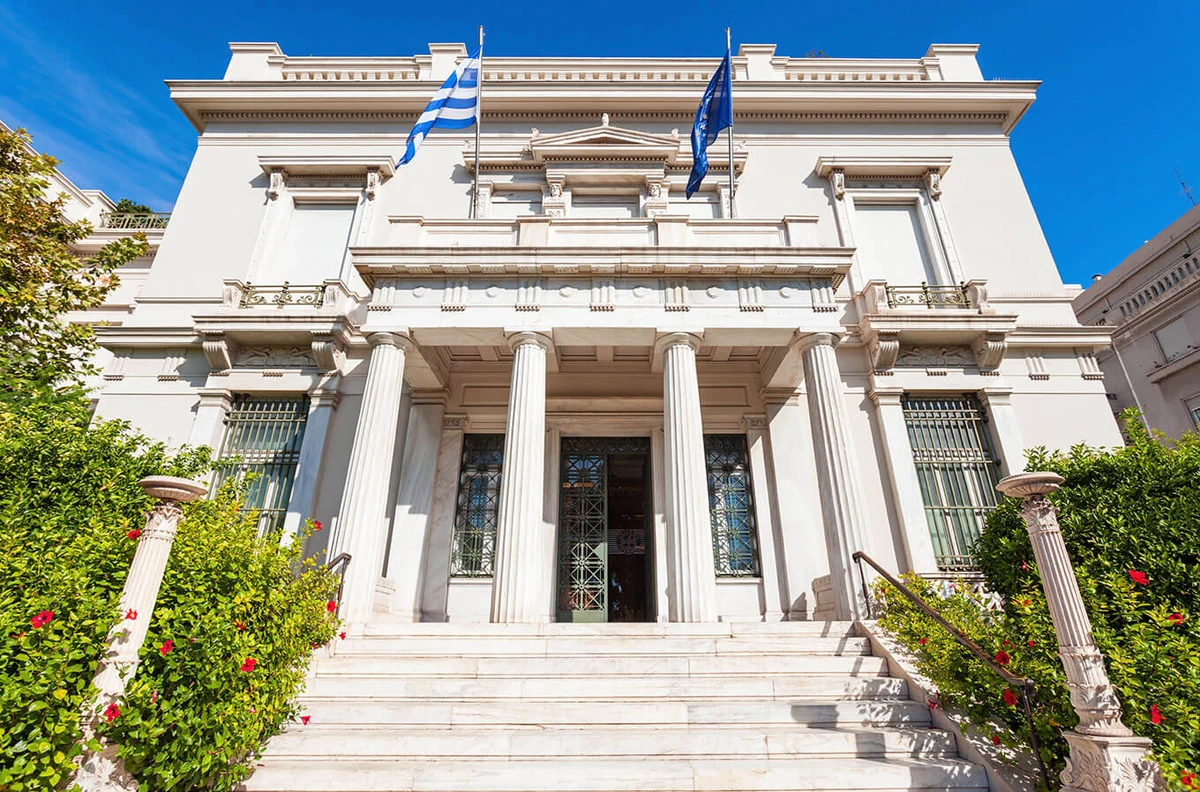 The Benaki Museum of Greek Culture, founded in 1930, owes its existence to Antonios Benakis, the son of a prominent politician and avid collector. Benakis donated his extensive collection along with the family mansion to create a museum. Since then, tens of thousands of other exhibits representing Greek history have been added, including jewelry, ceramic artifacts, marble portraits, manuscripts, religious icons, household utensils, clothing and textiles.
The Benaki Museum of Greek Culture, founded in 1930, owes its existence to Antonios Benakis, the son of a prominent politician and avid collector. Benakis donated his extensive collection along with the family mansion to create a museum. Since then, tens of thousands of other exhibits representing Greek history have been added, including jewelry, ceramic artifacts, marble portraits, manuscripts, religious icons, household utensils, clothing and textiles.
Just a few steps from the Benakis Museum is located Byzantine Museum.The Byzantine and Christian Museum contains over 30,000 items dating from the 3rd to the 21st century AD: icons, frescoes, mosaics, paleotypes, manuscripts, manuscripts, sculptures, small crafts, ceramics, textiles, paintings and more. All of them are classified in chronological order, according to materials and topics, and also digitized using electronic recording systems. Those items that are not on permanent display are kept under ideal conditions of humidity and temperature in modern storage facilities.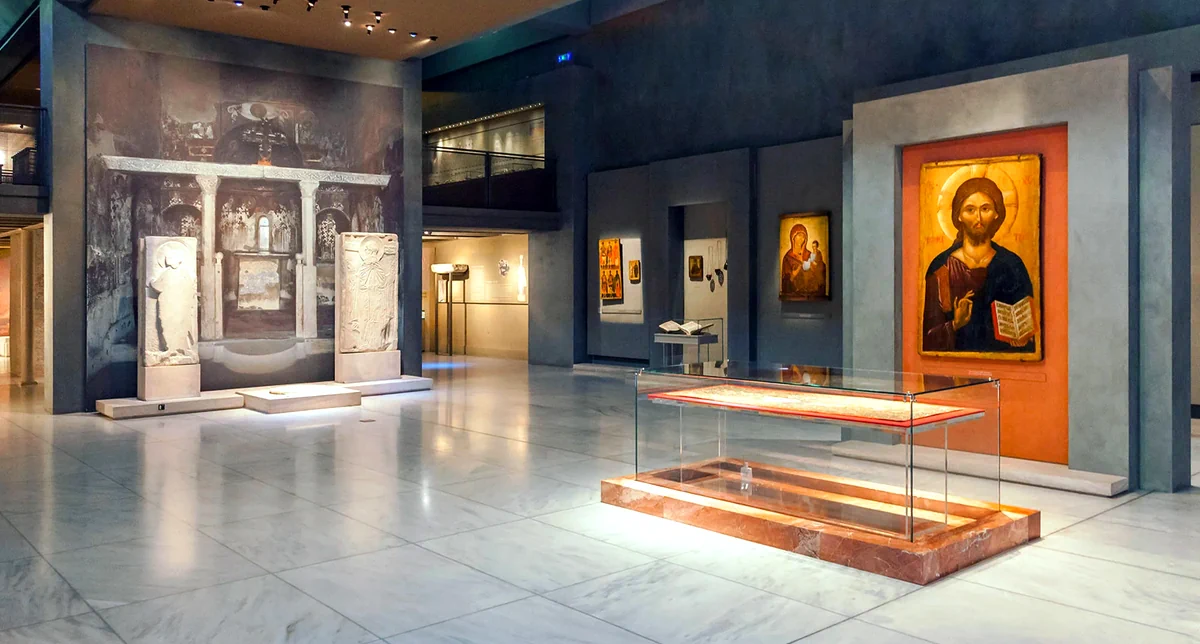 Walking towards the Lycabettus Hill you will meet the Athenian Military Museum. The Greek state, wishing to honor the memory of all those who fought for the freedom of our country, decided in 1964 to establish the Military Museum. The museum was opened in July 1975 and operates to this day.
Walking towards the Lycabettus Hill you will meet the Athenian Military Museum. The Greek state, wishing to honor the memory of all those who fought for the freedom of our country, decided in 1964 to establish the Military Museum. The museum was opened in July 1975 and operates to this day.
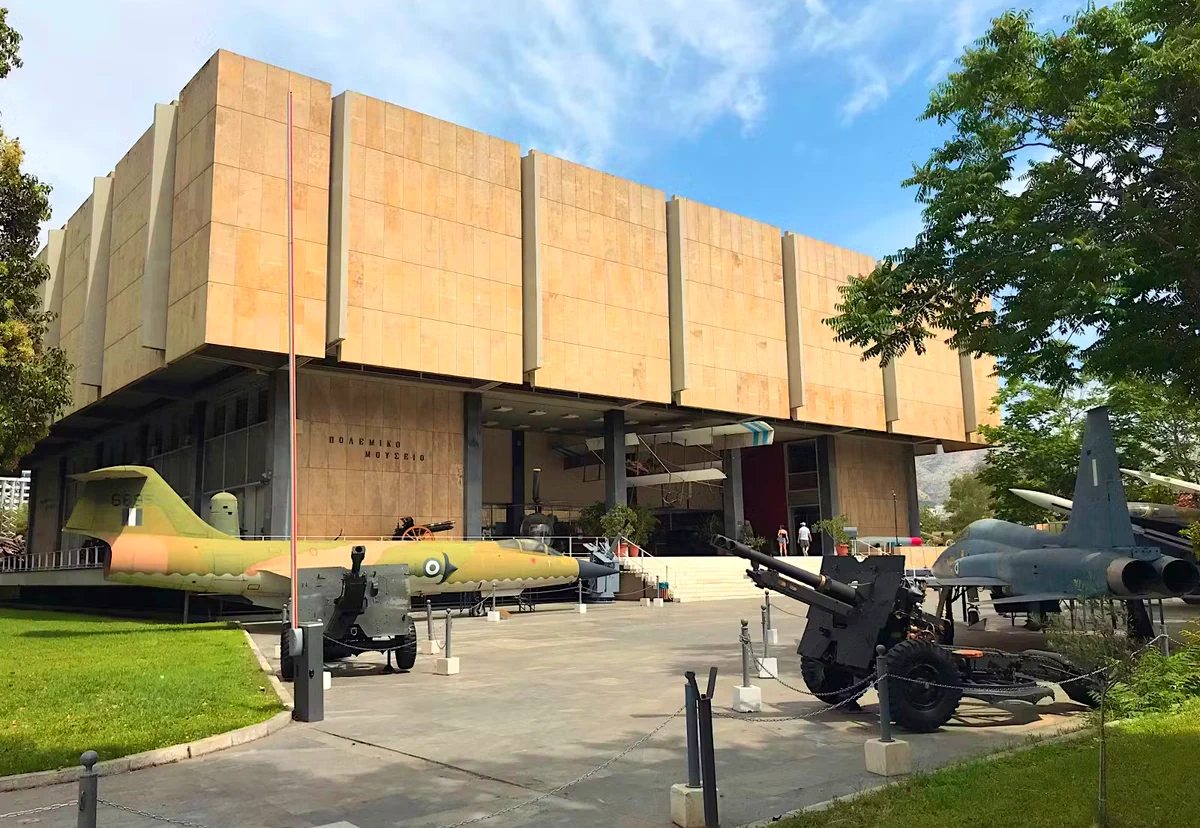 What could be better than dinner with a beautiful view of the hill of Lycabettus. According to mythology, Lycabettus Hill was formed after a rock fell from the hands of Athena, which she carried from Penteli when she went to the Acropolis.
What could be better than dinner with a beautiful view of the hill of Lycabettus. According to mythology, Lycabettus Hill was formed after a rock fell from the hands of Athena, which she carried from Penteli when she went to the Acropolis.
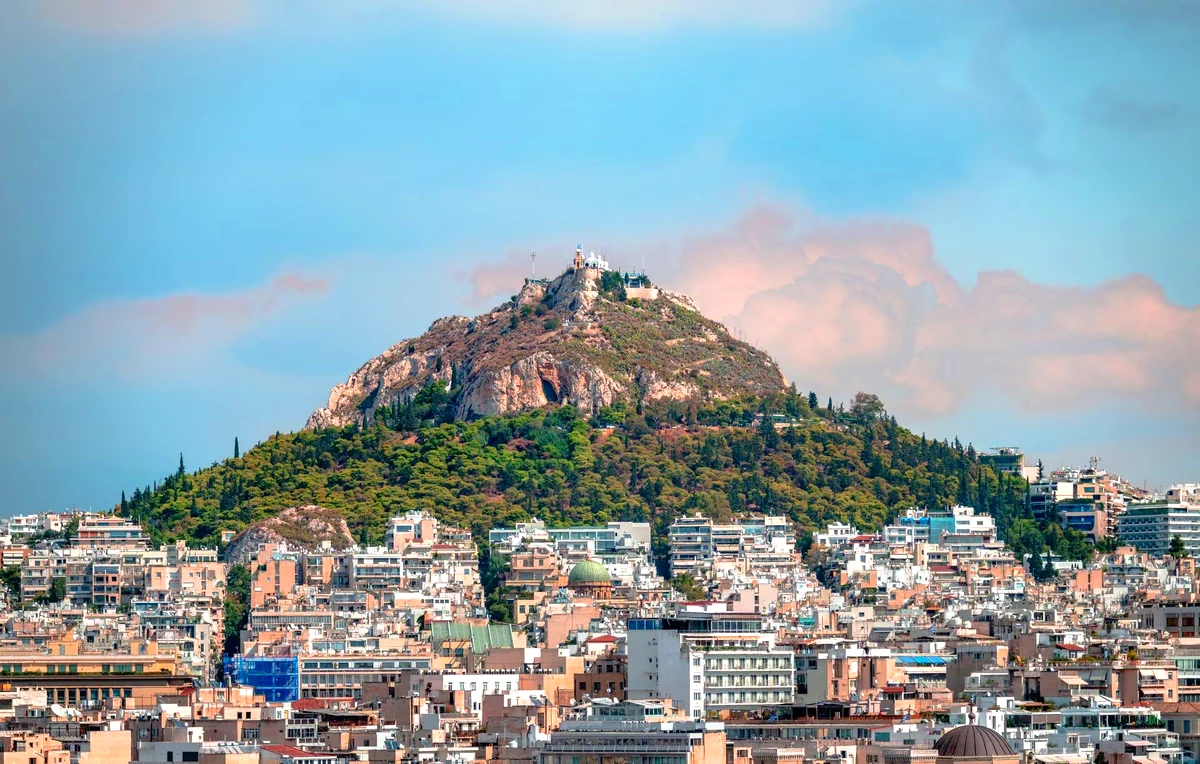 They say that she wanted to make her temple a little higher with the help of a rock, but on the way to the Acropolis she heard the news that the daughters of Cecropa opened the basket where Erichthonius lay, which she entrusted them to guard. Then the goddess Athena was alarmed, and the stone fell out of her hands. Thus arose what the Athenians would later call Lycabettus Hill.
They say that she wanted to make her temple a little higher with the help of a rock, but on the way to the Acropolis she heard the news that the daughters of Cecropa opened the basket where Erichthonius lay, which she entrusted them to guard. Then the goddess Athena was alarmed, and the stone fell out of her hands. Thus arose what the Athenians would later call Lycabettus Hill.
Many people don’t know that between Agia Isidora and the cafe Lycabettus, in 1939 the Lycabettus hideout was built. At a depth of 100 meters, in fact, to store state archives and protect high-ranking officials in case of danger.
You can reach the top of Lycabettus hill by teleferic (starting point at the crossroads of Plutarchou and Aristippou streets), or by footpath, enjoying very romantic views and a walk among the pines and thick bushes.
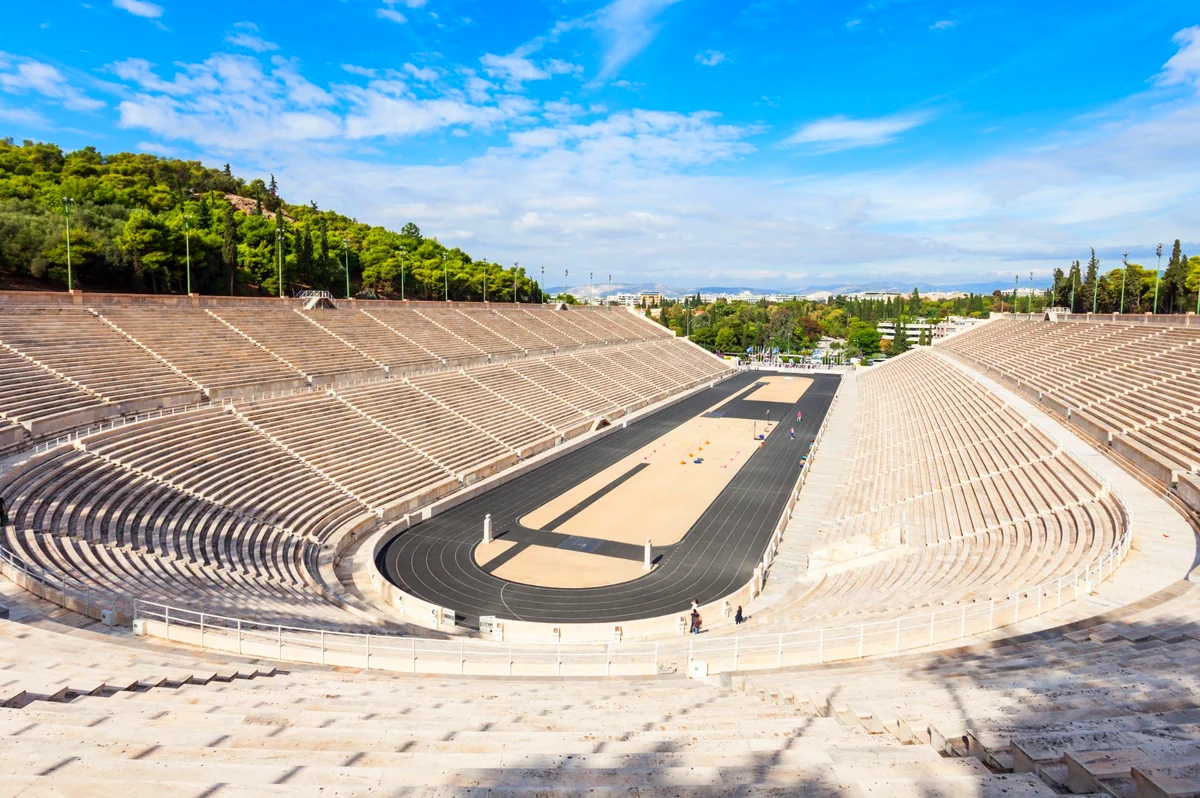 And so we start our day with Panathenaic Stadium, which is an eternal cultural and tourist symbol and one of the most important monuments of Athens and all of Greece.
And so we start our day with Panathenaic Stadium, which is an eternal cultural and tourist symbol and one of the most important monuments of Athens and all of Greece.
It attracts all visitors to our city and is a famous landmark of Athens. Its rich history is inextricably linked to the modern Olympic Games, from its revival in 1896 to its success in 2004. This is where the transfer of the Olympic flame takes place at all the Olympic Games.
In ancient times, it was used to hold part of the Panathenaic in honor of the goddess Athena. Built between the hills of Agra and Ardittos, in 329 BC, during the reign of Lycurgus, the stadium was completely covered in marble, since until that time the seats were wooden.
In AD 140, under Herod Atticus, a massive renovation was carried out, and the capacity was also increased to 50,000 seats. Since it was the only stadium made entirely of marble, it was plundered during military conflicts and completely restored in 1900.
Probably our advice to visit the first cemetery in Athens. It will seem strange to you, but do not rush to conclusions! Museum of sculptures in the open air, immersed in eternal silence.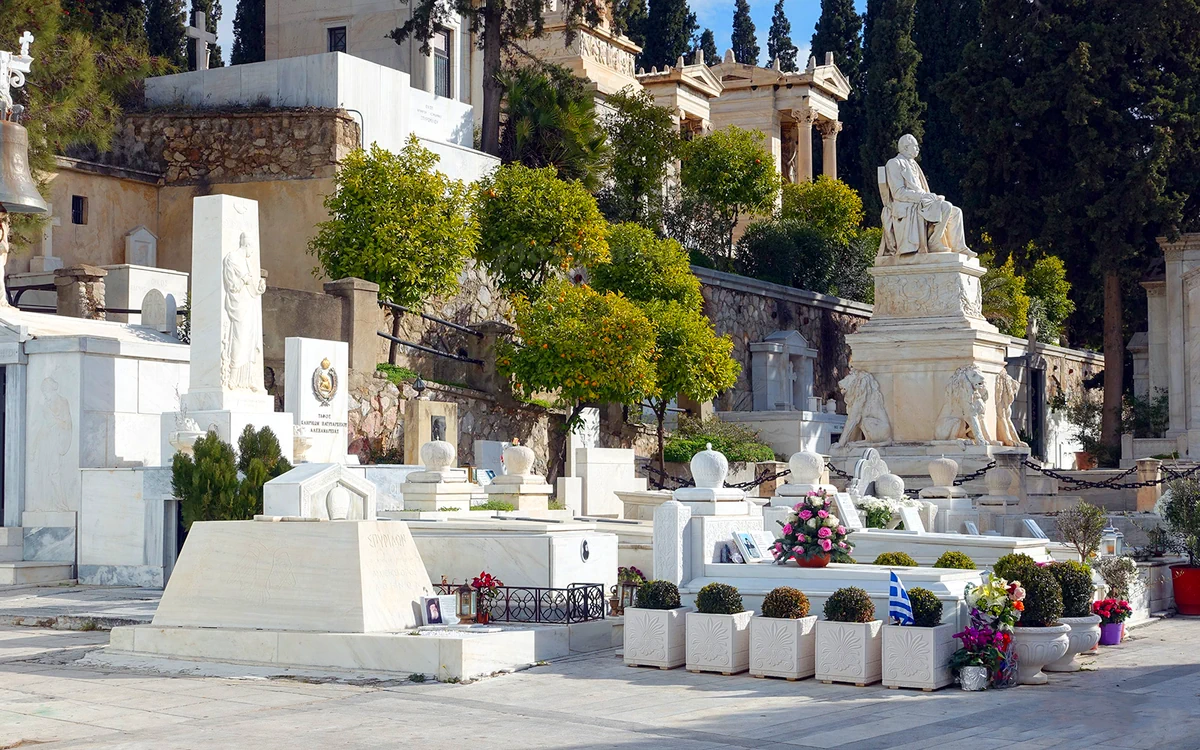 The Athens Cemetery is the oldest cemetery in the city that is still in operation. The first graves were around the church of Agios Lazaros, today they are located outside the main cemetery and are the resting places of personalities who left their mark on the history of this place.
The Athens Cemetery is the oldest cemetery in the city that is still in operation. The first graves were around the church of Agios Lazaros, today they are located outside the main cemetery and are the resting places of personalities who left their mark on the history of this place.
The cemetery contains dozens of works of art, mostly by contemporary sculptors and architects. Here, among the towering cypresses, pines and shrubs of the Mediterranean flora, you will see works created by important artists to always remind us of the passing of life.
Find the “Sleeping Beauty of Khalepa” and go on a walk from there that will surely amaze you. Among the many churches in the cemetery are the Catholic churches of St. Theodore and St. Charles, and in the southeast corner is the city’s Jewish cemetery.
Heinrich Schliemann, the explorer of ancient Troy, the architect Ernst Ziller, the actress Melina Mercouri and many other important figures who participated in the history of Greece are buried here. This is truly a worthwhile place.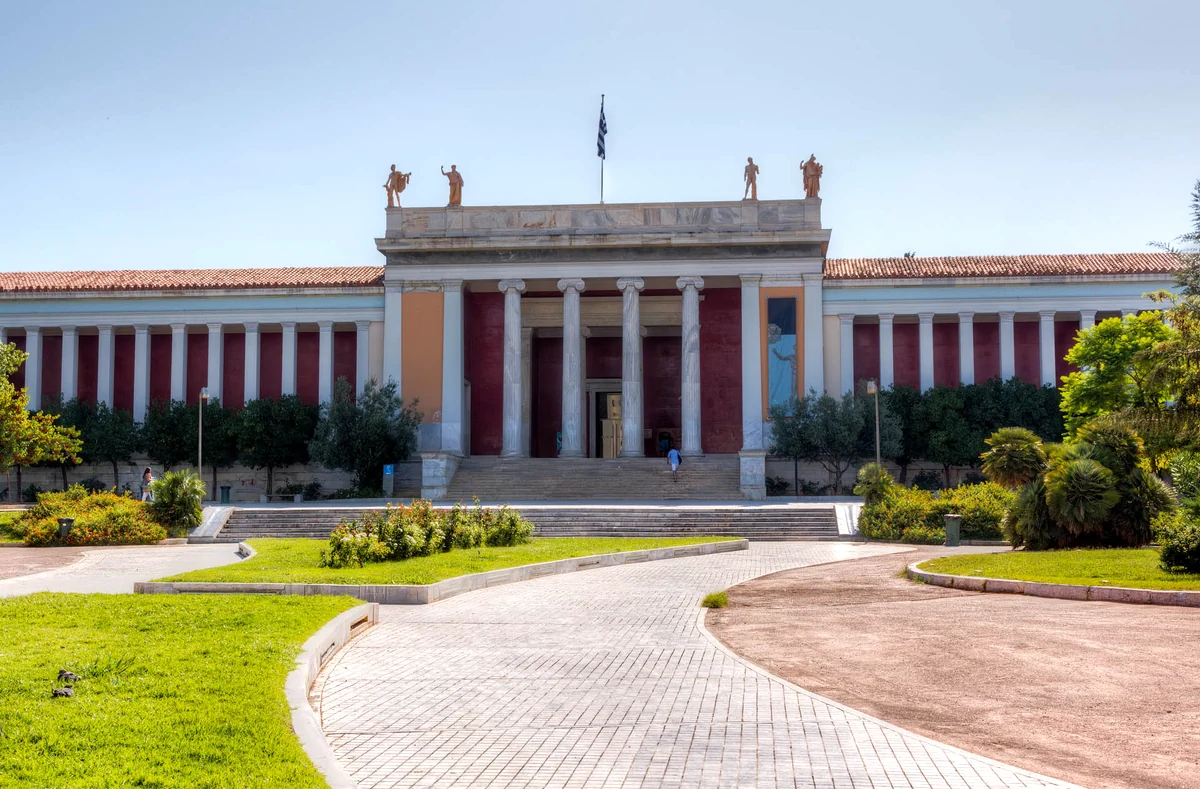 National Archaeological Museum – the largest museum in Greece and one of the most important in the world. Initially, it was intended for finds from excavations of the 19th century, mainly from Attica, but also from other regions of the country, but gradually it took the form of a central National Archaeological Museum and was replenished with finds of Greek civilization from all parts of the world. Its rich collections of over 11,000 exhibits offer the visitor a panorama of ancient Greek civilization from the beginning of prehistory to late antiquity. It will not be difficult to get to Victoria metro station on the green line or Omonia station on the red line.
🚩Museums in Athens
National Archaeological Museum – the largest museum in Greece and one of the most important in the world. Initially, it was intended for finds from excavations of the 19th century, mainly from Attica, but also from other regions of the country, but gradually it took the form of a central National Archaeological Museum and was replenished with finds of Greek civilization from all parts of the world. Its rich collections of over 11,000 exhibits offer the visitor a panorama of ancient Greek civilization from the beginning of prehistory to late antiquity. It will not be difficult to get to Victoria metro station on the green line or Omonia station on the red line.
🚩Museums in Athens
Greek car museum (Hellenic motor museum) occupies 4.000 sq.m. in a building with unique architecture and aesthetics. It focuses on the technology and evolution of the automobile and includes over 110 exhibits from the late 19th to the late 20th century. It is located in the center of Athens, a stone’s throw from the National Archaeological Museum.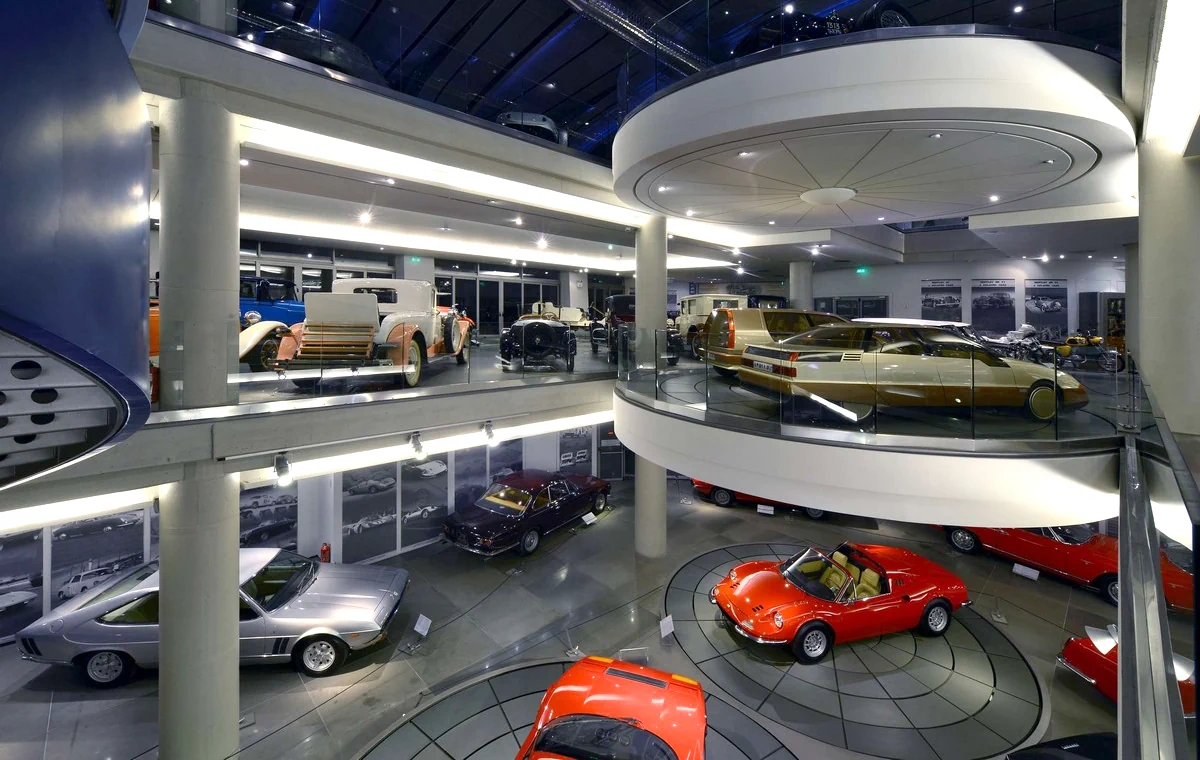 Then, sitting again on the green line in the direction of the port of Piraeus, you need to get off at Neo Faliro station. It is here that you will be transported to the atmosphere of a Mediterranean island. Over the years of its existence, it could receive many different names, but Microlimano, formerly known as Turkolimano, Fanari or the port of Kumunduru, and in antiquity as Limenas Munichia, is one of the most beautiful seaside areas of Athens.
Then, sitting again on the green line in the direction of the port of Piraeus, you need to get off at Neo Faliro station. It is here that you will be transported to the atmosphere of a Mediterranean island. Over the years of its existence, it could receive many different names, but Microlimano, formerly known as Turkolimano, Fanari or the port of Kumunduru, and in antiquity as Limenas Munichia, is one of the most beautiful seaside areas of Athens.
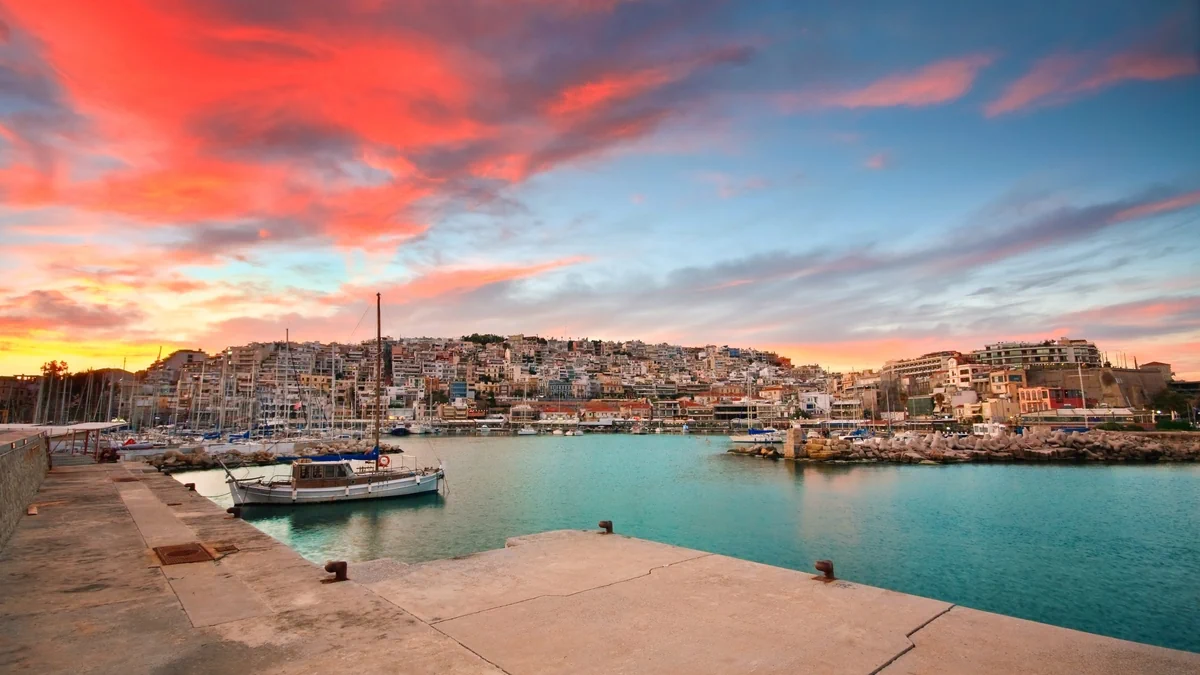 From a small port in ancient times, Mikrolimano has evolved today into a cosmopolitan holiday destination for residents and visitors alike. A walk along the sea and a delicious lunch in local taverns will plunge you into the local flavor.
From a small port in ancient times, Mikrolimano has evolved today into a cosmopolitan holiday destination for residents and visitors alike. A walk along the sea and a delicious lunch in local taverns will plunge you into the local flavor.
As you continue your walk along the coast, take the tram that moves towards the Glyfada area. When you reach the Trocadero stop, you need to get off. Just 5 minutes’ walk to the sea and you can visit the majestic museum on the water cruiser Averoff. This is perhaps the only warship in world naval history, which for almost half a century has been associated with the history of the country, inextricably linking its name with events of national importance, while never experiencing defeat and shame.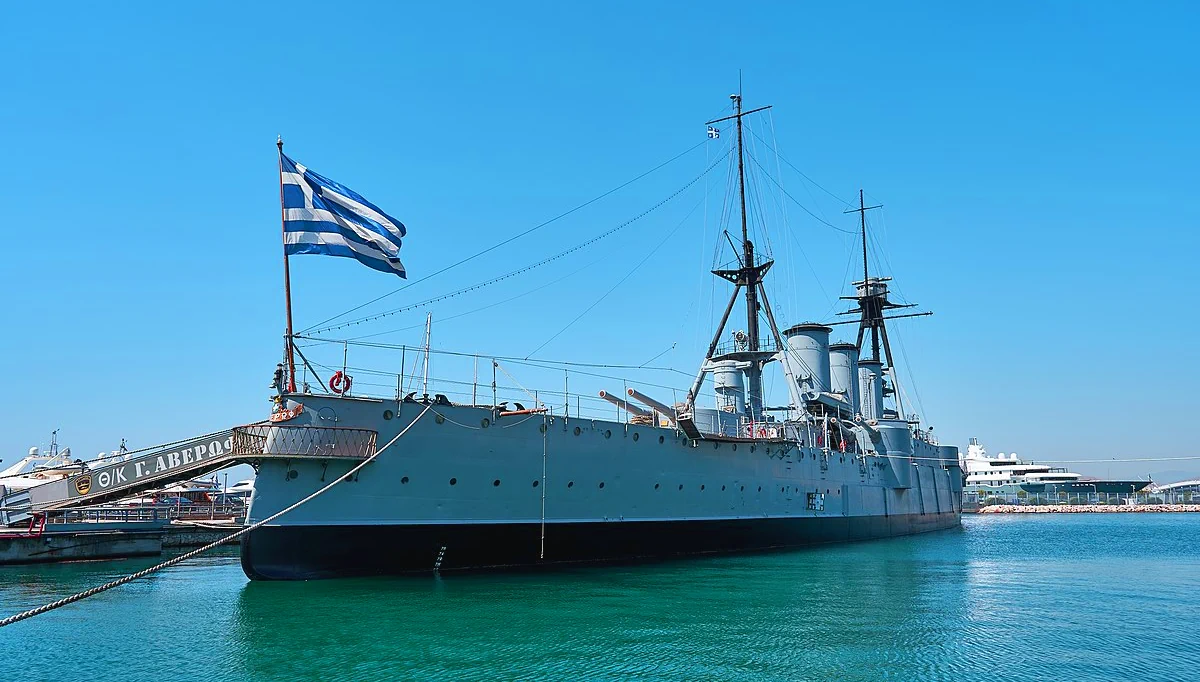 Averoff is a monument that honors the memory of those who have served and fallen throughout its glorious history while preserving the country’s naval traditions. It is really worth taking a look with your own eyes at a cruiser that went through two great wars and remained unscathed.
Averoff is a monument that honors the memory of those who have served and fallen throughout its glorious history while preserving the country’s naval traditions. It is really worth taking a look with your own eyes at a cruiser that went through two great wars and remained unscathed.
Lake Vulyagmeni on the southern coast of Athens, 260 meters long and 145 meters wide. Its waters come from a depth of 50 to 100 meters and have a temperature of 22°C to 29°C, indicating that at some depth it communicates with the Aegean volcanic arc.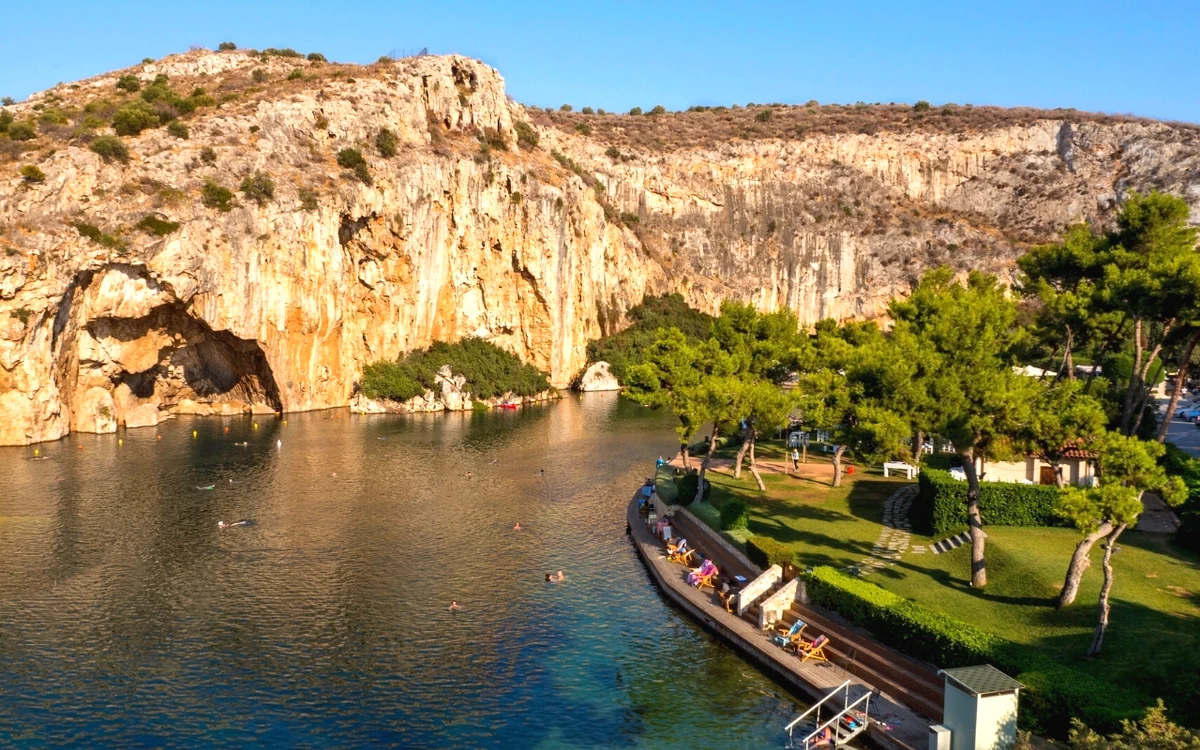 The lake is also fed by a freshwater spring at a depth of 17 meters. An underground cave leads to the lake, communicating with the sea through various galleries. The lake was formed as a result of the collapse of the vaults of a large underground cave about 2,000 years ago.
The lake is also fed by a freshwater spring at a depth of 17 meters. An underground cave leads to the lake, communicating with the sea through various galleries. The lake was formed as a result of the collapse of the vaults of a large underground cave about 2,000 years ago.
The cave is located in the limestone rocks of the area. The explored length of the cave is 3123 meters. There are 14 tunnels in the cave, and the bottom of the lake consists of a silty substrate rich in sulfur compounds.
The waters of the lake have an increased content of minerals and microelements, such as potassium, sodium, lithium, ammonium, calcium, iron, chlorine and iodine. The waters of the lake are indicated for rheumatic diseases, sports injuries, disorders of the nervous system, skin and gynecological diseases.
Since this area is considered elite, public transport runs at large intervals. You need to get to the Glyfada area, stop Kolegio and transfer to bus 117 or 122 and go to Limni Vouliagmenis.
If you still decide not to go to the lake, then a very good option to end the day is a walk towards Kallithea and Faliro in Stavros Niarchos Foundation Cultural Center. A very beautiful architectural solution, combined with romantic night lighting, attracts both young people and families with children. During the summer, Xefoto often hosts events until midnight, and open-air cafes and taverns in different parts of the park are a great stop for a snack.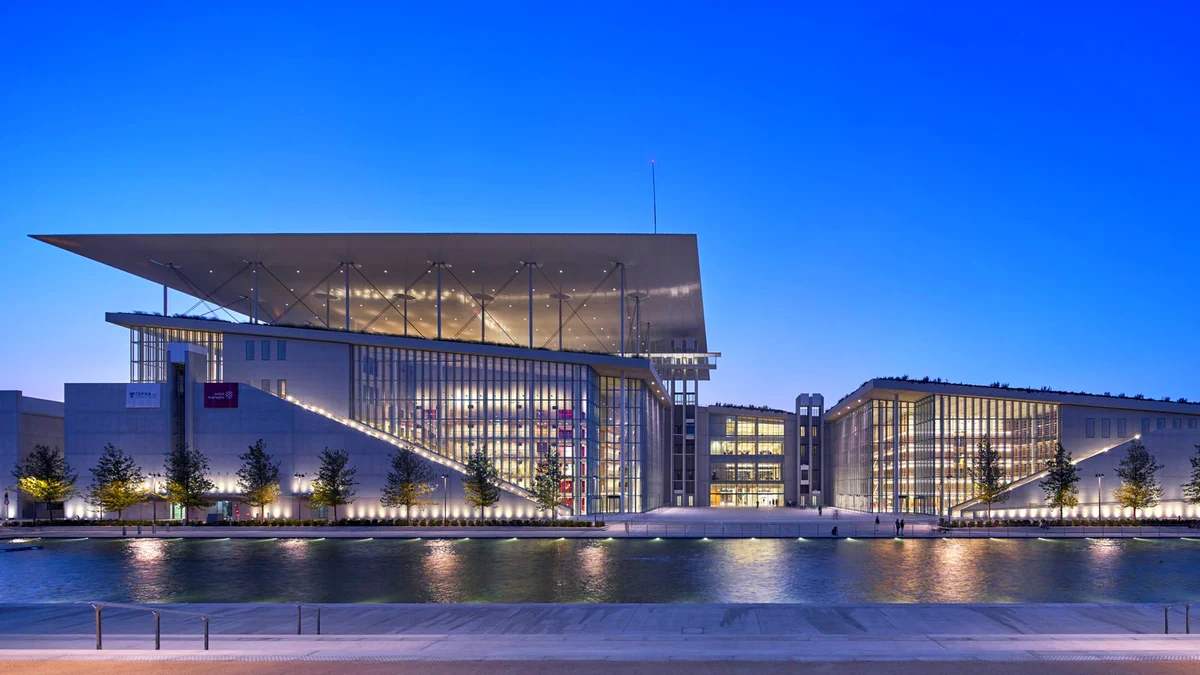 On this wonderful note, the third day in the capital of the majestic Hellas, the city of Athens, came to an end. I hope we have immersed you in the culture and customs of the locals as much as possible. As it was originally said, Athens has very good transport links, so you can easily move around the city.
On this wonderful note, the third day in the capital of the majestic Hellas, the city of Athens, came to an end. I hope we have immersed you in the culture and customs of the locals as much as possible. As it was originally said, Athens has very good transport links, so you can easily move around the city.
If you have not purchased a travel card, then there is another interesting tip, this is a sightseeing bus that runs on several routes and you can sit on it as many times as you want within the aisles of the ticket. You can take a ticket for 2 days and enjoy the surrounding views. It is better to buy tickets for these buses on the Internet in advance, you can often find very advantageous offers. Enjoy your holiday to the full without wasting a minute.
 Often Athens is not the final destination or the only one for the guests of Hellas. Usually, having visited some other region of Greece, guests also visit the capital, or vice versa.
Often Athens is not the final destination or the only one for the guests of Hellas. Usually, having visited some other region of Greece, guests also visit the capital, or vice versa.
The city has good transport links and all types of public transport are available for every taste and budget.
Arriving at the airport of Athens, following the signs, after 3 minutes you will find yourself in the metro, go to the central square of Sindagma in just 30 minutes on the red line, the ticket price is 9 euros. Well, if you want to save a little, then on the street near the arrival terminal, there is a bus stop X95 which also goes to the central square and costs 5.5-6.5 (depending on where you buy the ticket), just ride it for about 50 minutes.
A very profitable option is to purchase a three-day tourist pass for all types of public transport, including a trip from and to the airport, the cost of such a ticket is 20 euros. After boarding the bus, the ticket must be brought to the scanner, from that moment it will begin to operate.
When you are planning a visit to Athens, it would be more logical to settle closer to the center in order to save time on the road and see as many sights as possible, of which there are an incredible number.
🏨 Find hotels in Athens
1️⃣ First day
And so, in order not to lose a minute, we begin our journey through the city. First day During your stay, you need to get acquainted with the most famous place of the city – the Acropolis and the sights adjacent to it. Monuments of the Acropolis, harmoniously combined with the surrounding nature, are unique masterpieces of ancient architecture.
Monuments of the Acropolis, harmoniously combined with the surrounding nature, are unique masterpieces of ancient architecture.
If you settled in the center, then we advise you to walk along the streets of Athens and enjoy the Hellenic flavor. Depending on the season, the opening hours of the facilities also change, keep in mind. For all municipal attractions and museums, information on opening hours and entrance fees can be found here: odysseus.culture.gr
On a rocky hill Acropolis, towering above the center of modern Athens, was the largest and most grandiose sanctuary of the ancient city, dedicated primarily to its patron goddess Athena.
The most important myths of ancient Athens, the main religious holidays, the oldest cults of the city and some of the most important events in its history are associated with this sanctuary.
Parthenon, standing majestically on the highest point of the Acropolis, this impressive temple was the most majestic in the ancient world. For a better view of the Parthenon from afar, head to Philopappos hill right in front of the Acropolis.
 Wandering through the numerous archaeological finds of the Acropolis, you follow in the footsteps of Socrates, Pericles and Sophocles and discover the architecture of Western civilization. Since the Acropolis Parthenon was the center of attention, there are many sights around it which must be visited.
Wandering through the numerous archaeological finds of the Acropolis, you follow in the footsteps of Socrates, Pericles and Sophocles and discover the architecture of Western civilization. Since the Acropolis Parthenon was the center of attention, there are many sights around it which must be visited.
Before entering the territory of the Acropolis, you can go to amphitheater of Herod Atticus. This ancient theater is named after Herod Atticus of Marathon, who built it in memory of his wife Regilla in 161 AD, despite the date of construction, it is very well preserved.
 Beule Gate is located under the western side of the Propylaea, the magnificent entrance to the Acropolis. The gate with two side towers dates back to 280 BC. and were originally connected to the Propylaea by a wide marble staircase built during the reign of Emperor Septimius Sivir.
Beule Gate is located under the western side of the Propylaea, the magnificent entrance to the Acropolis. The gate with two side towers dates back to 280 BC. and were originally connected to the Propylaea by a wide marble staircase built during the reign of Emperor Septimius Sivir.
Temple of Athena Nike – the most elegant and well-preserved of all the buildings of the Acropolis, restored in the 19th and 20th centuries. Situated on a rocky cliff on the southern side of the Propylaea, this ancient sanctuary was dedicated to the victory-bringing goddess Athena (Nika). The temple was built between 432 and 421. BC, after the completion of the Parthenon and Propylaea.
 On the western side of the hill, tomb of king Erechtheion. One of the most famous features of the Erechtheion is the Veranda of the Caryatids – six marble columns in the form of figures of girls supporting the roof, fascinate with their appearance.
On the western side of the hill, tomb of king Erechtheion. One of the most famous features of the Erechtheion is the Veranda of the Caryatids – six marble columns in the form of figures of girls supporting the roof, fascinate with their appearance.
Pandroseion located between the Erechtheion and the Old Temple of Athena Polias. This small temple was named after Pandrosia, daughter of the first king of Athens. The temple contained the altar of Zeus Herkeyos (the patron saint of the hearth) and the sanctuary of Pandora. Scientists believe that the sacred snakes of the Acropolis were kept here.
Ancient Athenian Agora,located northwest of the Acropolis, in ancient times it was the administrative, philosophical, educational, social, cultural and especially economic center of the city.
 Roman Agora was the central market in ancient Athens during the Roman Empire. It was here that commercial transactions and meetings took place. The Roman market was created as an extension of the ancient market (Athensian Agora) to meet the needs of the daily life of the city. When the construction of the Roman market was completed, this street was decorated with a beautiful passage.
Roman Agora was the central market in ancient Athens during the Roman Empire. It was here that commercial transactions and meetings took place. The Roman market was created as an extension of the ancient market (Athensian Agora) to meet the needs of the daily life of the city. When the construction of the Roman market was completed, this street was decorated with a beautiful passage.
The Acropolis Museum is a must-visit cultural attraction in Athens. Beneath the hill of the Acropolis, about 300 meters from the archaeological site, this incomparable museum contains one of the most valuable collections of ancient Greek art in the entire world.
 Theater of Dionysus fourth century BC – the oldest of the three architectural complexes built on the southern slopes of the Acropolis (Areopagite Street). The tragedies of Sophocles and Euripides were played here for the first time.
Theater of Dionysus fourth century BC – the oldest of the three architectural complexes built on the southern slopes of the Acropolis (Areopagite Street). The tragedies of Sophocles and Euripides were played here for the first time.
 Hadrian’s Gate (or Hadrian’s Arch) – this is a monumental gate, reminiscent – according to some opinions – of a Roman triumphal arch. They blocked the ancient road from the center of Athens to the settlement complex on the eastern side of the city, which contained the Temple of Olympian Zeus.
Hadrian’s Gate (or Hadrian’s Arch) – this is a monumental gate, reminiscent – according to some opinions – of a Roman triumphal arch. They blocked the ancient road from the center of Athens to the settlement complex on the eastern side of the city, which contained the Temple of Olympian Zeus.
Temple of Zeus, one of the most important and most visited sanctuaries of ancient Athens, whose fate coincided with the political changes that took place in the city over the centuries. It is located southeast of the Acropolis.
 I can say with accuracy that after so many sights you are hungry and need a rest. Around the Acropolis Museum and near the Acropolis metro station, there are many local taverns and restaurants for every taste. It should be noted that the view of the acropolis is especially mesmerizing in the evening.
I can say with accuracy that after so many sights you are hungry and need a rest. Around the Acropolis Museum and near the Acropolis metro station, there are many local taverns and restaurants for every taste. It should be noted that the view of the acropolis is especially mesmerizing in the evening.
2️⃣ Second day
If you are lucky enough to be in Athens on Sunday, then you will be able to appreciate Greek patriotism and become witnesses to the changing of the guard of honor. This breathtaking spectacle, accompanied by the accompaniment of the state orchestra, starts at 11 am every Sunday near the Parliament on the main Syntagma Square. If you are in the capital on another day, then you can watch a miniature of this procession every hour.
If you are in the capital on another day, then you can watch a miniature of this procession every hour.
A band of Evzones (meaning “well-dressed”) was created by King Otto for the personal protection of the royal family. Their uniforms were based on the traditional costumes of the southern Greeks of the 19th century. The red fez symbolizes the bloodshed of 21 revolutions against the Turks, the black border is the tears of the Greeks during the Turkish occupation, and the 400 folds on the skirt are 400 years of slavery under the Turks.
In the first half of the day, it is worth taking a walk along the narrow shopping streets of the city, such as Ermou street, walking along it from the central square you will get to Monastiraki.
 Monastiraki square is part of an old Catholic monastery. During the Frankish rule it was a private Monastery of Nicholas Bonefatsis. Located nearby Mosque of Tsistrakis, built by the Turkish governor Tsistarakis in 1759 from material obtained by destroying ancient buildings. For the marble plastering of the walls, the 17th column of the Temple of Olympian Zeus was blown up. The old Athenians believed that under every pillar of the temple lay a curse, which was confirmed by the outbreak of famine in the city.
Monastiraki square is part of an old Catholic monastery. During the Frankish rule it was a private Monastery of Nicholas Bonefatsis. Located nearby Mosque of Tsistrakis, built by the Turkish governor Tsistarakis in 1759 from material obtained by destroying ancient buildings. For the marble plastering of the walls, the 17th column of the Temple of Olympian Zeus was blown up. The old Athenians believed that under every pillar of the temple lay a curse, which was confirmed by the outbreak of famine in the city.
From the Monastiraki metro station you can get to any part of the city, if you have purchased a 3-day pass, take advantage of the moment and ride the tram around the city.
Near Monastiraki Square is located Abyssinia square where is located market (“Yusurum”), formerly known for its antique shops.
 Today, there are still many antique dealers here. If you are a collector, this area is not to be missed. It is worth noting that this historical place is bordered by no less picturesque Plaka district.The best way to enjoy the color of these streets is to walk along them.
Today, there are still many antique dealers here. If you are a collector, this area is not to be missed. It is worth noting that this historical place is bordered by no less picturesque Plaka district.The best way to enjoy the color of these streets is to walk along them.
Buildings over 100 years old, painted in pastel colors, will take you centuries into the past. Is Plaka the oldest street in Europe? We are talking about Trypodon Street, which has retained the same name for almost twenty-five centuries.
Since Plaka is one of the oldest parts of Athens, this is where you will find many Byzantine and post-Byzantine churches. The most famous of them is Saint Nicholas Ragava and Savior Likodim. Built in the 11th century on Prytaneiu Street, in Anafiotika. In Byzantine times, the area around the church was the most aristocratic quarter of Athens. As for the name, the church was built by the grandson of the Byzantine emperor Michael Ragabas I on the site of a former Roman temple.
 Another historic building worth spending time on is − Church of the Savior Lykodem, better known as the “Russian Church”. It was first built around 1031 AD and restored in the 19th century. Today it is the largest surviving medieval building in Athens. Located on Phillinon Street, opposite the National Garden.
Another historic building worth spending time on is − Church of the Savior Lykodem, better known as the “Russian Church”. It was first built around 1031 AD and restored in the 19th century. Today it is the largest surviving medieval building in Athens. Located on Phillinon Street, opposite the National Garden.
Walking through the historical places of the city you will find yourself in the national garden. You must have noticed it before. On hot summer days, the best time to visit it is lunch. When the sun heats up asphalt and marble outside, you can enjoy the coolness under the crowns of numerous trees. Together with the garden of the Zappeion Palace, it covers 284 acres full of greenery, rare species of plants, trees and birds.
 The garden can be accessed from seven entrances. From the main entrance on Amalias Avenue, from Vasilissis Sophia Avenue, from three entrances on Irodu Atticus Street and from two more in the Zappeion Park area.
The garden can be accessed from seven entrances. From the main entrance on Amalias Avenue, from Vasilissis Sophia Avenue, from three entrances on Irodu Atticus Street and from two more in the Zappeion Park area.
Before being renamed the National Garden in 1924, the garden was called the Royal Garden or Amalia Garden, to which it owes its rare existence. The interest of Queen Amalia, King Otto’s wife, in the garden was so great that it is said that she spent at least three hours a day tending it. She also planted the garden’s characteristic Washingtonia, about 25 m high, which can be seen when entering the garden from Royal Avenue Amalia.
An attraction that fascinates not only foreign visitors to the Garden, but also the Athenians themselves, is the famous sundial located at the main entrance. The shadow of the arrow, depending on the position of the sun, shows the relative time, and everyone goes on an adventure to guess the exact time without looking at the clock or mobile phone, thus mentally traveling for some time into the distant past.
One of the most beautiful neoclassical buildings in Athens, opposite the National Garden and the Greek Parliament building, houses one of the most impressive museums: Benaki Museum of Hellenic Culture, where you will find unique works from the beginning of Greek history to the creation of the modern Greek state.
 The Benaki Museum of Greek Culture, founded in 1930, owes its existence to Antonios Benakis, the son of a prominent politician and avid collector. Benakis donated his extensive collection along with the family mansion to create a museum. Since then, tens of thousands of other exhibits representing Greek history have been added, including jewelry, ceramic artifacts, marble portraits, manuscripts, religious icons, household utensils, clothing and textiles.
The Benaki Museum of Greek Culture, founded in 1930, owes its existence to Antonios Benakis, the son of a prominent politician and avid collector. Benakis donated his extensive collection along with the family mansion to create a museum. Since then, tens of thousands of other exhibits representing Greek history have been added, including jewelry, ceramic artifacts, marble portraits, manuscripts, religious icons, household utensils, clothing and textiles.
Just a few steps from the Benakis Museum is located Byzantine Museum.The Byzantine and Christian Museum contains over 30,000 items dating from the 3rd to the 21st century AD: icons, frescoes, mosaics, paleotypes, manuscripts, manuscripts, sculptures, small crafts, ceramics, textiles, paintings and more. All of them are classified in chronological order, according to materials and topics, and also digitized using electronic recording systems. Those items that are not on permanent display are kept under ideal conditions of humidity and temperature in modern storage facilities.
 Walking towards the Lycabettus Hill you will meet the Athenian Military Museum. The Greek state, wishing to honor the memory of all those who fought for the freedom of our country, decided in 1964 to establish the Military Museum. The museum was opened in July 1975 and operates to this day.
Walking towards the Lycabettus Hill you will meet the Athenian Military Museum. The Greek state, wishing to honor the memory of all those who fought for the freedom of our country, decided in 1964 to establish the Military Museum. The museum was opened in July 1975 and operates to this day.
 What could be better than dinner with a beautiful view of the hill of Lycabettus. According to mythology, Lycabettus Hill was formed after a rock fell from the hands of Athena, which she carried from Penteli when she went to the Acropolis.
What could be better than dinner with a beautiful view of the hill of Lycabettus. According to mythology, Lycabettus Hill was formed after a rock fell from the hands of Athena, which she carried from Penteli when she went to the Acropolis.
 They say that she wanted to make her temple a little higher with the help of a rock, but on the way to the Acropolis she heard the news that the daughters of Cecropa opened the basket where Erichthonius lay, which she entrusted them to guard. Then the goddess Athena was alarmed, and the stone fell out of her hands. Thus arose what the Athenians would later call Lycabettus Hill.
They say that she wanted to make her temple a little higher with the help of a rock, but on the way to the Acropolis she heard the news that the daughters of Cecropa opened the basket where Erichthonius lay, which she entrusted them to guard. Then the goddess Athena was alarmed, and the stone fell out of her hands. Thus arose what the Athenians would later call Lycabettus Hill.
Many people don’t know that between Agia Isidora and the cafe Lycabettus, in 1939 the Lycabettus hideout was built. At a depth of 100 meters, in fact, to store state archives and protect high-ranking officials in case of danger.
You can reach the top of Lycabettus hill by teleferic (starting point at the crossroads of Plutarchou and Aristippou streets), or by footpath, enjoying very romantic views and a walk among the pines and thick bushes.
3️⃣ The third day
This day will probably be the most interesting of all, the objects that will be offered for visiting are very unusual and impressive. And so we start our day with Panathenaic Stadium, which is an eternal cultural and tourist symbol and one of the most important monuments of Athens and all of Greece.
And so we start our day with Panathenaic Stadium, which is an eternal cultural and tourist symbol and one of the most important monuments of Athens and all of Greece.
It attracts all visitors to our city and is a famous landmark of Athens. Its rich history is inextricably linked to the modern Olympic Games, from its revival in 1896 to its success in 2004. This is where the transfer of the Olympic flame takes place at all the Olympic Games.
In ancient times, it was used to hold part of the Panathenaic in honor of the goddess Athena. Built between the hills of Agra and Ardittos, in 329 BC, during the reign of Lycurgus, the stadium was completely covered in marble, since until that time the seats were wooden.
In AD 140, under Herod Atticus, a massive renovation was carried out, and the capacity was also increased to 50,000 seats. Since it was the only stadium made entirely of marble, it was plundered during military conflicts and completely restored in 1900.
Probably our advice to visit the first cemetery in Athens. It will seem strange to you, but do not rush to conclusions! Museum of sculptures in the open air, immersed in eternal silence.
 The Athens Cemetery is the oldest cemetery in the city that is still in operation. The first graves were around the church of Agios Lazaros, today they are located outside the main cemetery and are the resting places of personalities who left their mark on the history of this place.
The Athens Cemetery is the oldest cemetery in the city that is still in operation. The first graves were around the church of Agios Lazaros, today they are located outside the main cemetery and are the resting places of personalities who left their mark on the history of this place.
The cemetery contains dozens of works of art, mostly by contemporary sculptors and architects. Here, among the towering cypresses, pines and shrubs of the Mediterranean flora, you will see works created by important artists to always remind us of the passing of life.
Find the “Sleeping Beauty of Khalepa” and go on a walk from there that will surely amaze you. Among the many churches in the cemetery are the Catholic churches of St. Theodore and St. Charles, and in the southeast corner is the city’s Jewish cemetery.
Heinrich Schliemann, the explorer of ancient Troy, the architect Ernst Ziller, the actress Melina Mercouri and many other important figures who participated in the history of Greece are buried here. This is truly a worthwhile place.
 National Archaeological Museum – the largest museum in Greece and one of the most important in the world. Initially, it was intended for finds from excavations of the 19th century, mainly from Attica, but also from other regions of the country, but gradually it took the form of a central National Archaeological Museum and was replenished with finds of Greek civilization from all parts of the world. Its rich collections of over 11,000 exhibits offer the visitor a panorama of ancient Greek civilization from the beginning of prehistory to late antiquity. It will not be difficult to get to Victoria metro station on the green line or Omonia station on the red line.
🚩Museums in Athens
National Archaeological Museum – the largest museum in Greece and one of the most important in the world. Initially, it was intended for finds from excavations of the 19th century, mainly from Attica, but also from other regions of the country, but gradually it took the form of a central National Archaeological Museum and was replenished with finds of Greek civilization from all parts of the world. Its rich collections of over 11,000 exhibits offer the visitor a panorama of ancient Greek civilization from the beginning of prehistory to late antiquity. It will not be difficult to get to Victoria metro station on the green line or Omonia station on the red line.
🚩Museums in Athens
Greek car museum (Hellenic motor museum) occupies 4.000 sq.m. in a building with unique architecture and aesthetics. It focuses on the technology and evolution of the automobile and includes over 110 exhibits from the late 19th to the late 20th century. It is located in the center of Athens, a stone’s throw from the National Archaeological Museum.
 Then, sitting again on the green line in the direction of the port of Piraeus, you need to get off at Neo Faliro station. It is here that you will be transported to the atmosphere of a Mediterranean island. Over the years of its existence, it could receive many different names, but Microlimano, formerly known as Turkolimano, Fanari or the port of Kumunduru, and in antiquity as Limenas Munichia, is one of the most beautiful seaside areas of Athens.
Then, sitting again on the green line in the direction of the port of Piraeus, you need to get off at Neo Faliro station. It is here that you will be transported to the atmosphere of a Mediterranean island. Over the years of its existence, it could receive many different names, but Microlimano, formerly known as Turkolimano, Fanari or the port of Kumunduru, and in antiquity as Limenas Munichia, is one of the most beautiful seaside areas of Athens.
 From a small port in ancient times, Mikrolimano has evolved today into a cosmopolitan holiday destination for residents and visitors alike. A walk along the sea and a delicious lunch in local taverns will plunge you into the local flavor.
From a small port in ancient times, Mikrolimano has evolved today into a cosmopolitan holiday destination for residents and visitors alike. A walk along the sea and a delicious lunch in local taverns will plunge you into the local flavor.
As you continue your walk along the coast, take the tram that moves towards the Glyfada area. When you reach the Trocadero stop, you need to get off. Just 5 minutes’ walk to the sea and you can visit the majestic museum on the water cruiser Averoff. This is perhaps the only warship in world naval history, which for almost half a century has been associated with the history of the country, inextricably linking its name with events of national importance, while never experiencing defeat and shame.
 Averoff is a monument that honors the memory of those who have served and fallen throughout its glorious history while preserving the country’s naval traditions. It is really worth taking a look with your own eyes at a cruiser that went through two great wars and remained unscathed.
Averoff is a monument that honors the memory of those who have served and fallen throughout its glorious history while preserving the country’s naval traditions. It is really worth taking a look with your own eyes at a cruiser that went through two great wars and remained unscathed.
Lake Vulyagmeni on the southern coast of Athens, 260 meters long and 145 meters wide. Its waters come from a depth of 50 to 100 meters and have a temperature of 22°C to 29°C, indicating that at some depth it communicates with the Aegean volcanic arc.
 The lake is also fed by a freshwater spring at a depth of 17 meters. An underground cave leads to the lake, communicating with the sea through various galleries. The lake was formed as a result of the collapse of the vaults of a large underground cave about 2,000 years ago.
The lake is also fed by a freshwater spring at a depth of 17 meters. An underground cave leads to the lake, communicating with the sea through various galleries. The lake was formed as a result of the collapse of the vaults of a large underground cave about 2,000 years ago.
The cave is located in the limestone rocks of the area. The explored length of the cave is 3123 meters. There are 14 tunnels in the cave, and the bottom of the lake consists of a silty substrate rich in sulfur compounds.
The waters of the lake have an increased content of minerals and microelements, such as potassium, sodium, lithium, ammonium, calcium, iron, chlorine and iodine. The waters of the lake are indicated for rheumatic diseases, sports injuries, disorders of the nervous system, skin and gynecological diseases.
Since this area is considered elite, public transport runs at large intervals. You need to get to the Glyfada area, stop Kolegio and transfer to bus 117 or 122 and go to Limni Vouliagmenis.
If you still decide not to go to the lake, then a very good option to end the day is a walk towards Kallithea and Faliro in Stavros Niarchos Foundation Cultural Center. A very beautiful architectural solution, combined with romantic night lighting, attracts both young people and families with children. During the summer, Xefoto often hosts events until midnight, and open-air cafes and taverns in different parts of the park are a great stop for a snack.
 On this wonderful note, the third day in the capital of the majestic Hellas, the city of Athens, came to an end. I hope we have immersed you in the culture and customs of the locals as much as possible. As it was originally said, Athens has very good transport links, so you can easily move around the city.
On this wonderful note, the third day in the capital of the majestic Hellas, the city of Athens, came to an end. I hope we have immersed you in the culture and customs of the locals as much as possible. As it was originally said, Athens has very good transport links, so you can easily move around the city.
If you have not purchased a travel card, then there is another interesting tip, this is a sightseeing bus that runs on several routes and you can sit on it as many times as you want within the aisles of the ticket. You can take a ticket for 2 days and enjoy the surrounding views. It is better to buy tickets for these buses on the Internet in advance, you can often find very advantageous offers. Enjoy your holiday to the full without wasting a minute.
-

Discover the Enchanting Flavors of Santorini Wines
Enjoy Santorini’s volcanic wines – a taste of paradise in Greece.
-

Discover the Stunning Beaches of Corfu
Let’s dive into the top beaches of Corfu and explore the beauty they have to offer!
-

Top 15 Beaches of Rhodes
Discover the top 15 beaches of Rhodes. Enjoy the crystal-clear waters, golden sands, and stunning scenery of this beautiful Greek island.